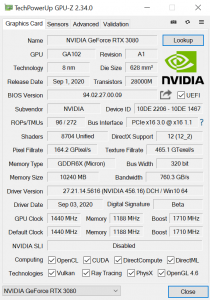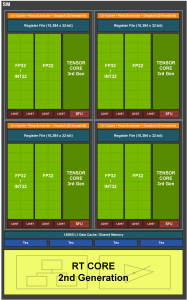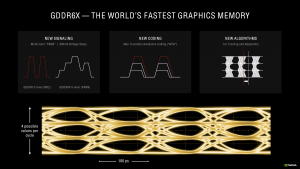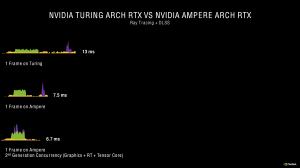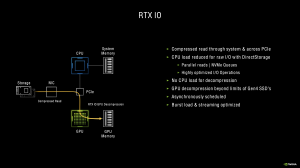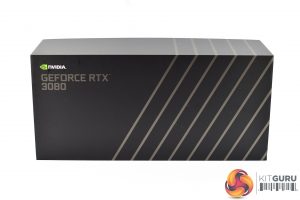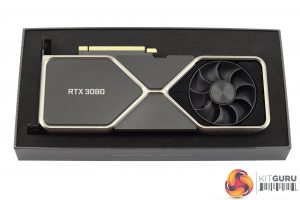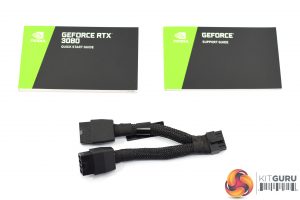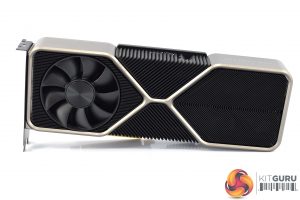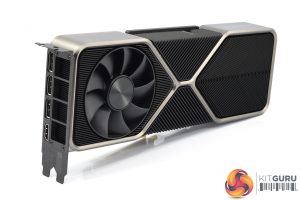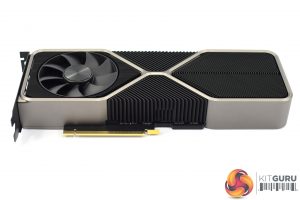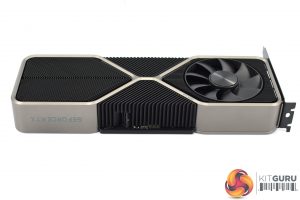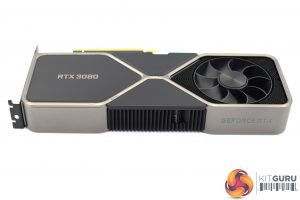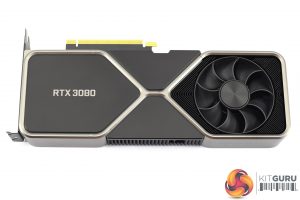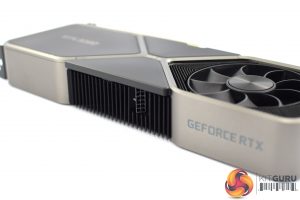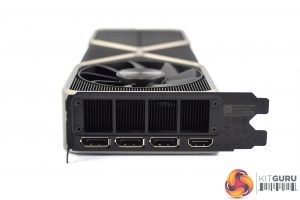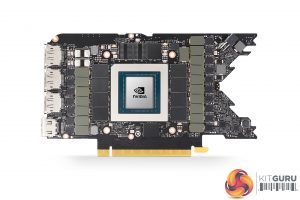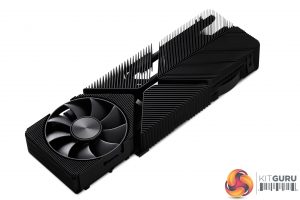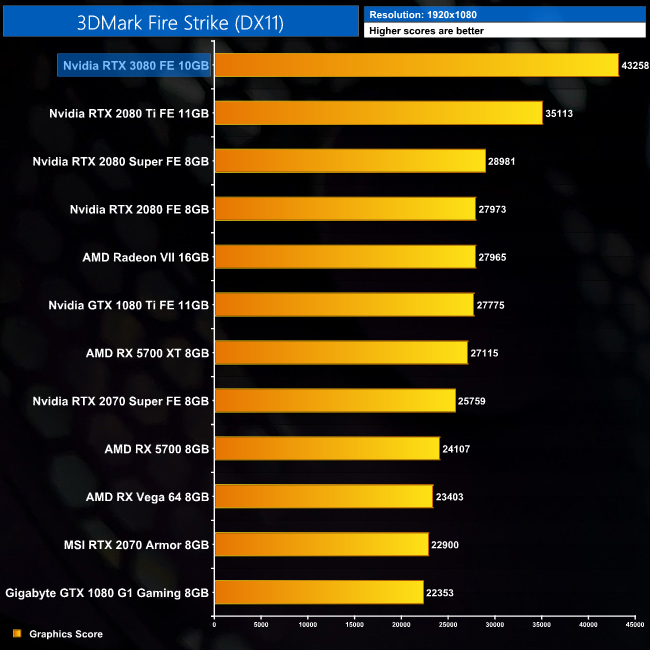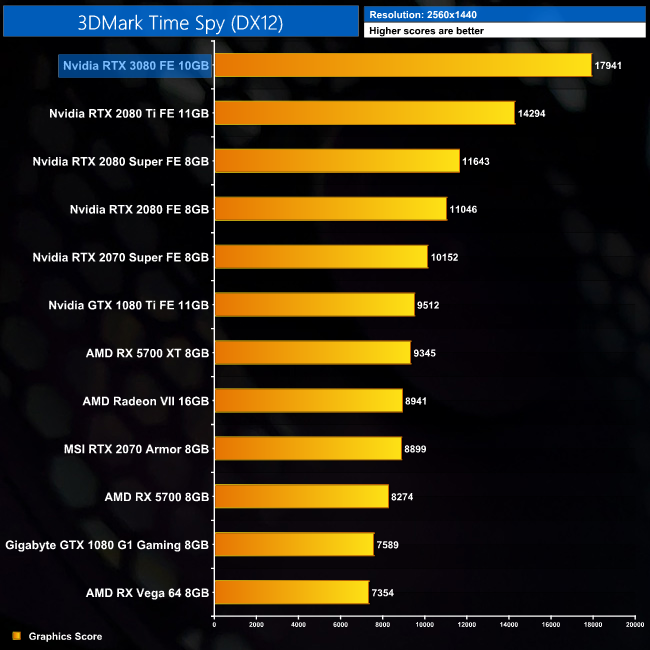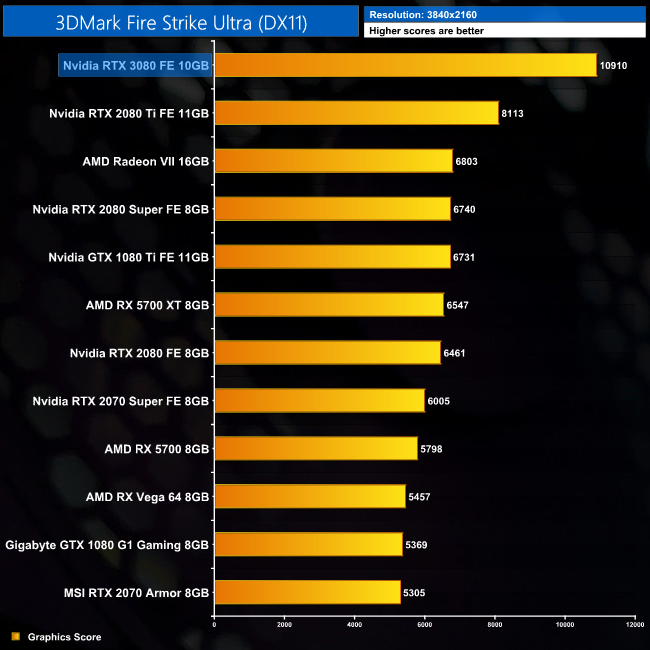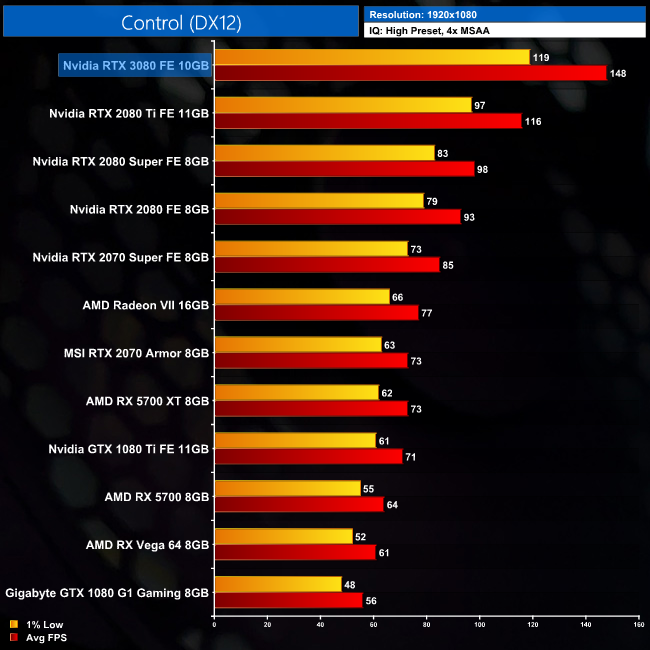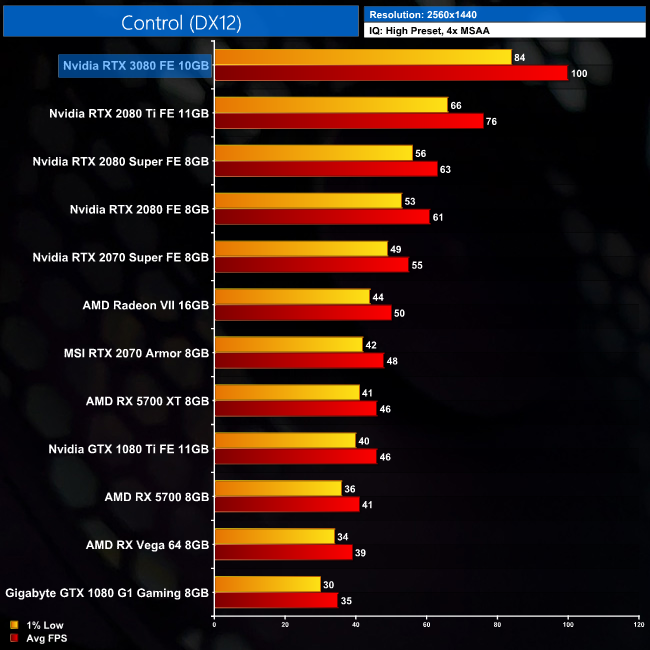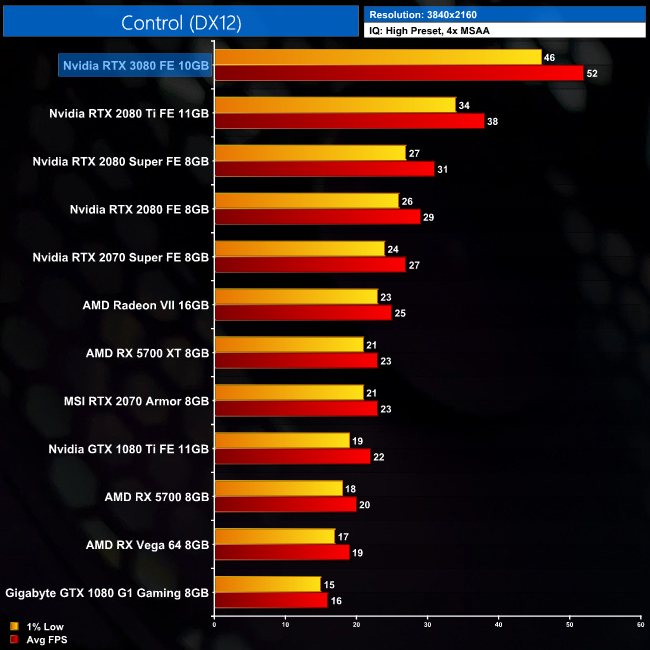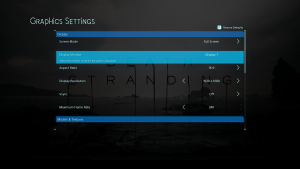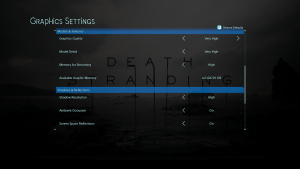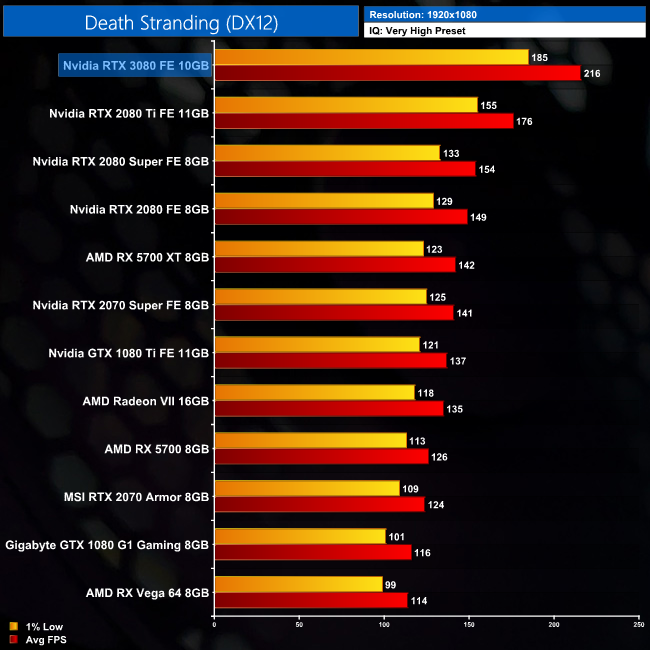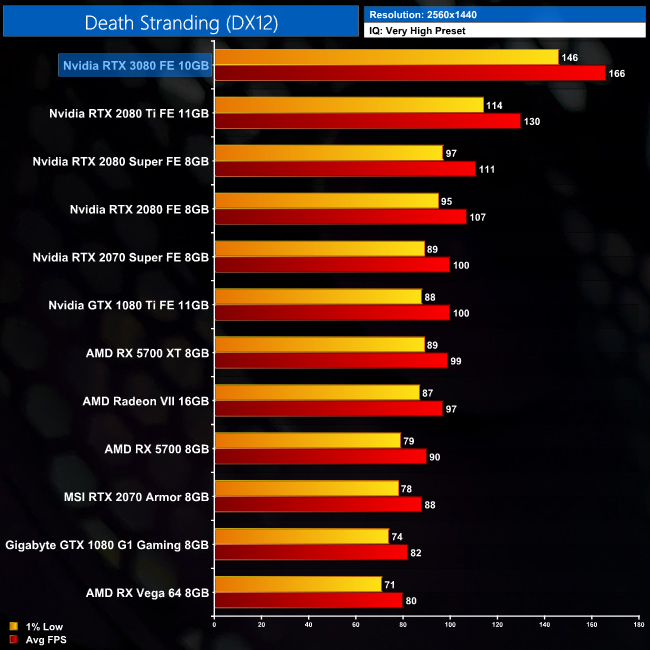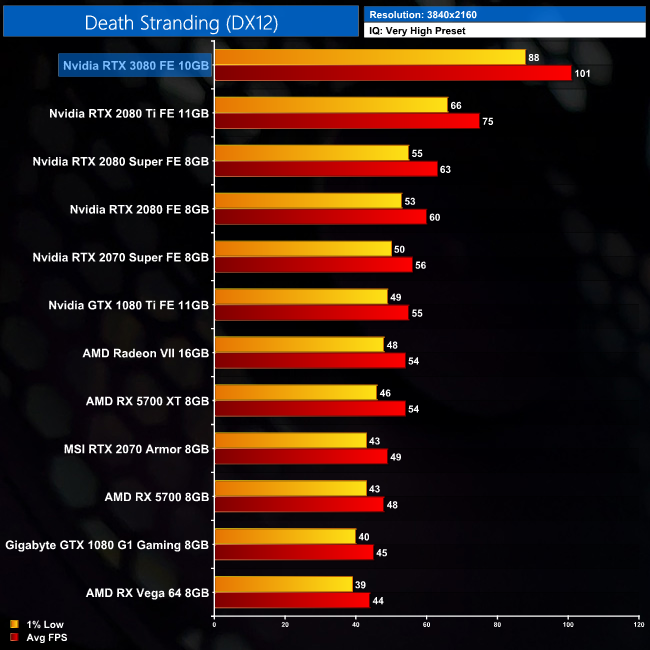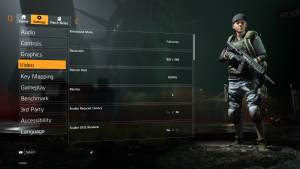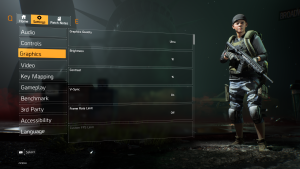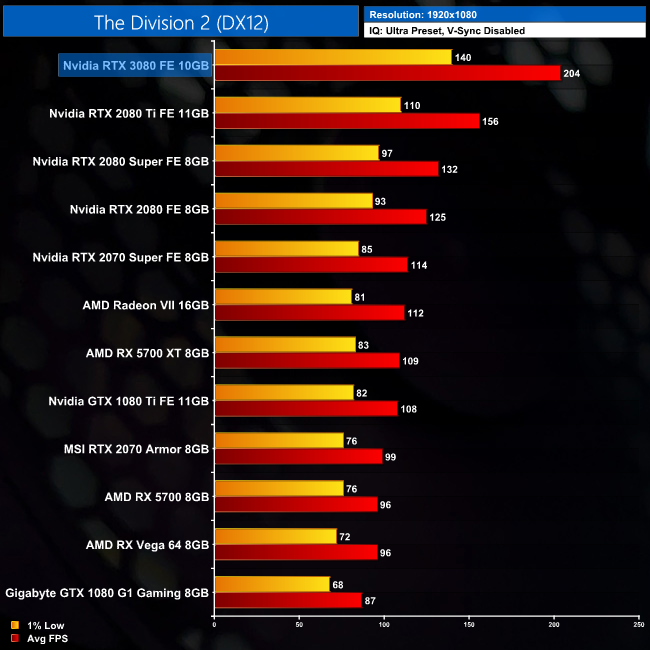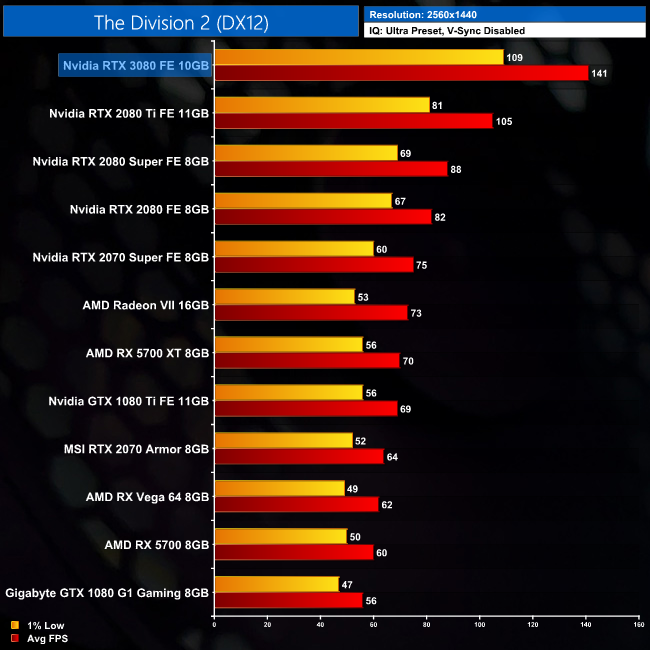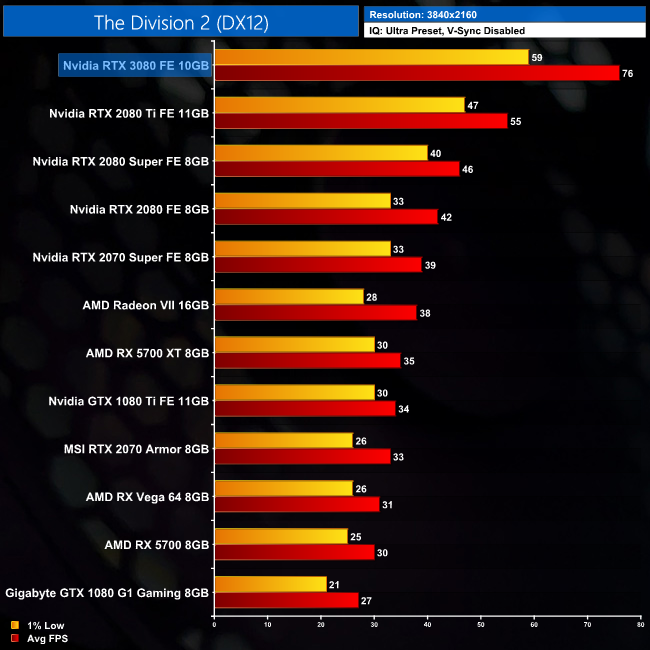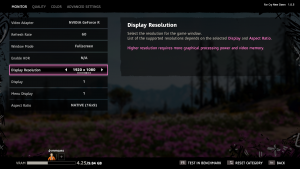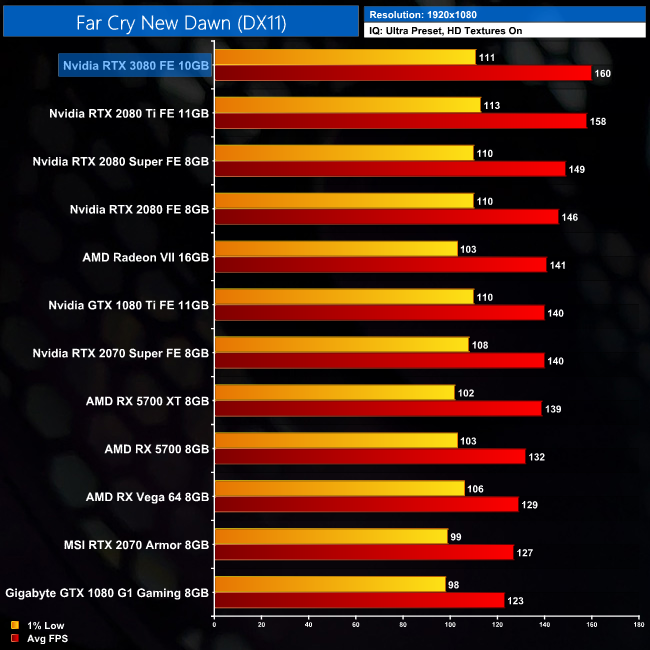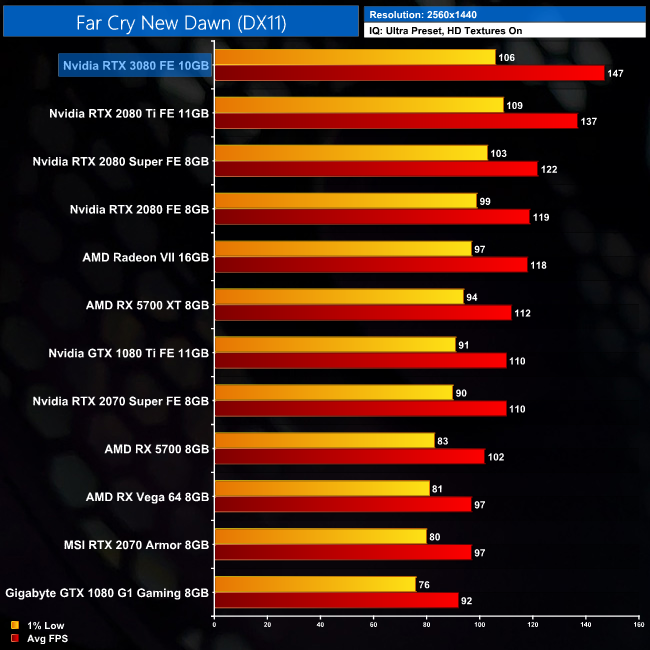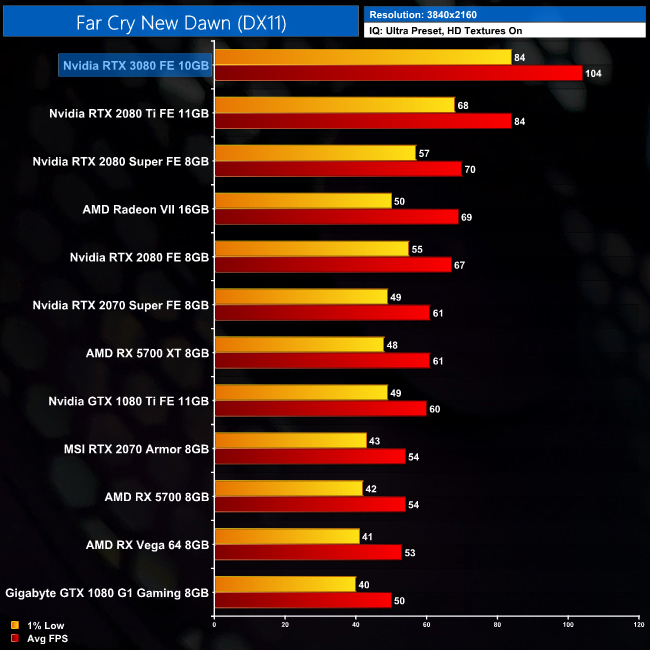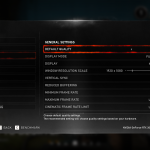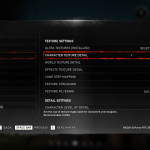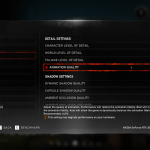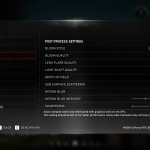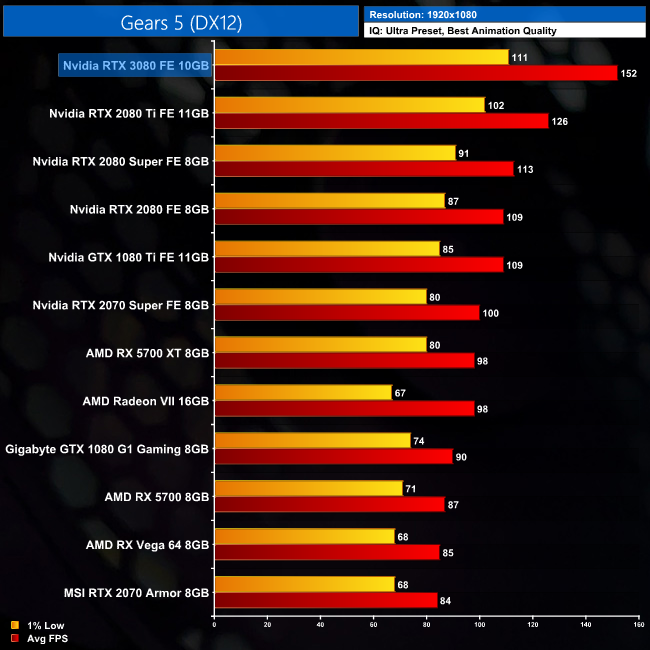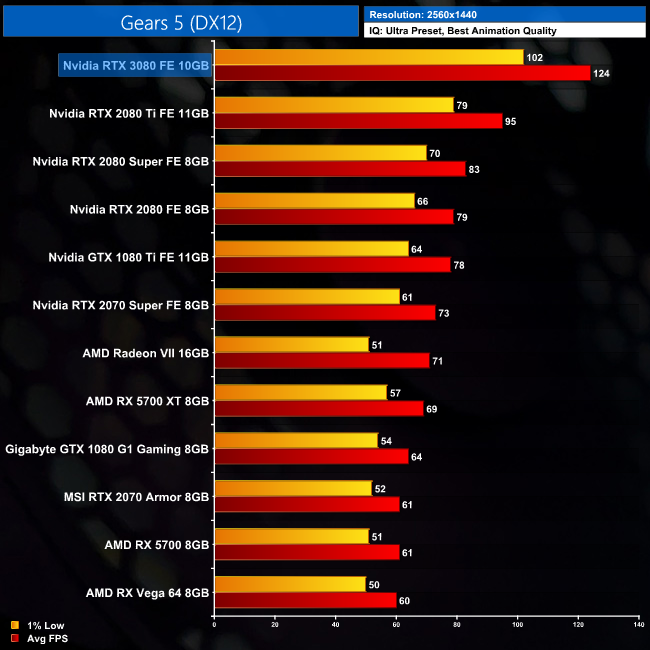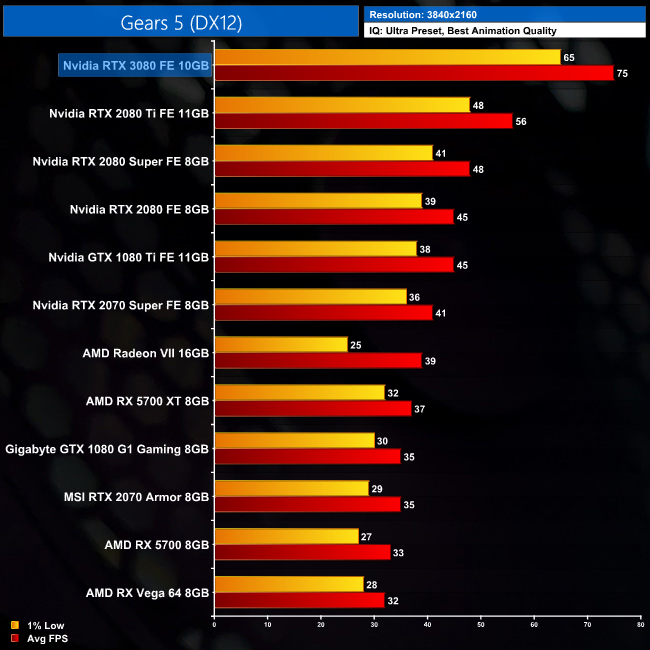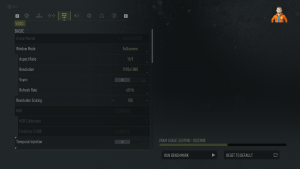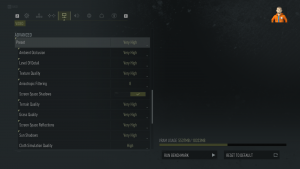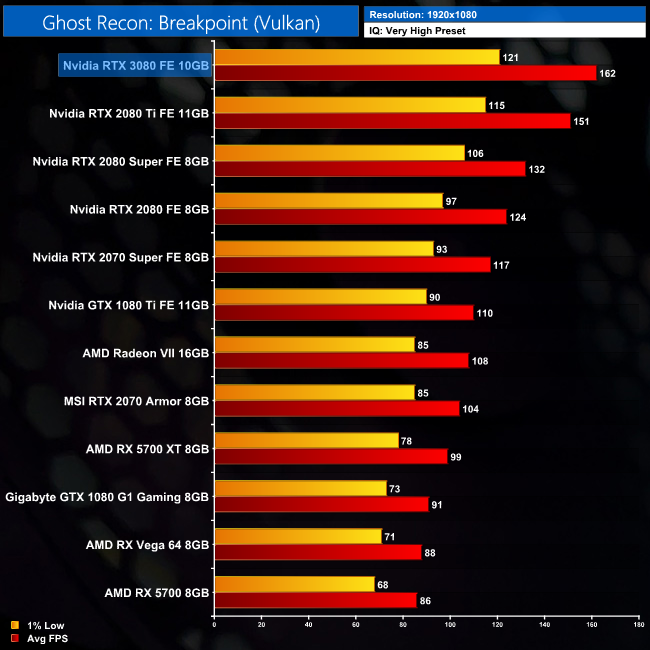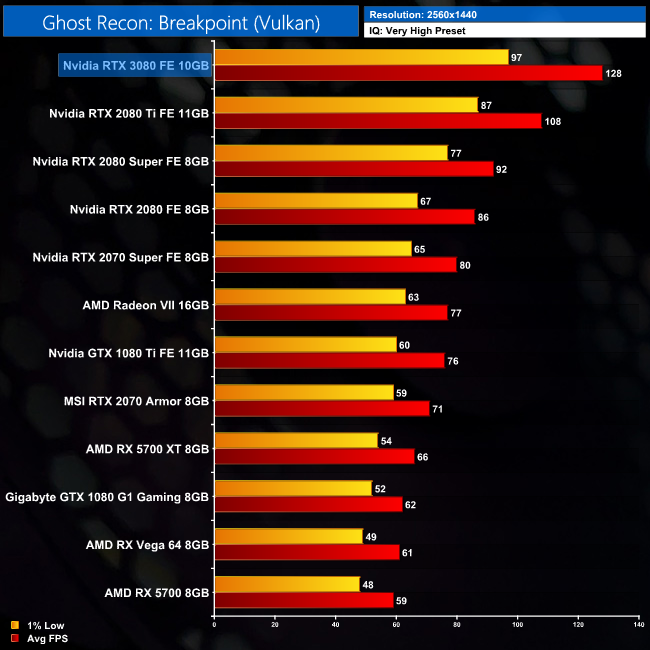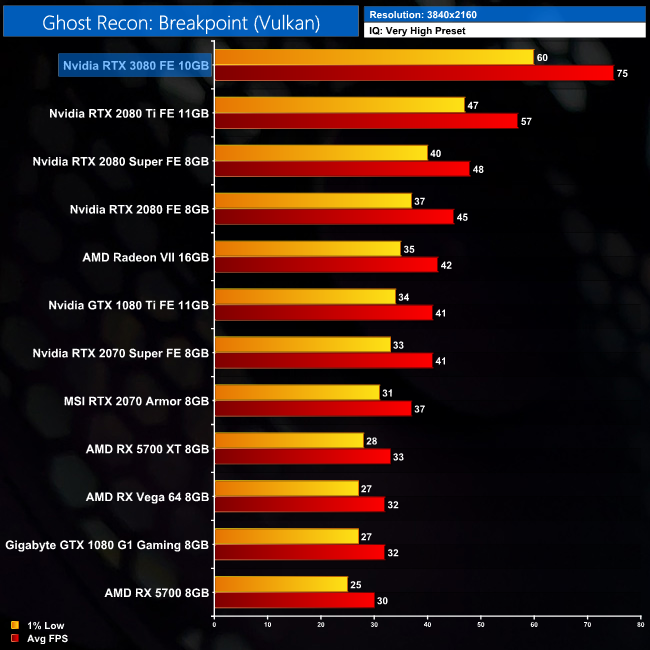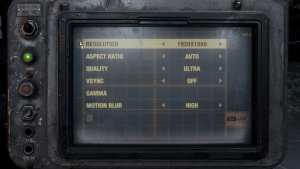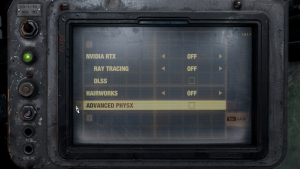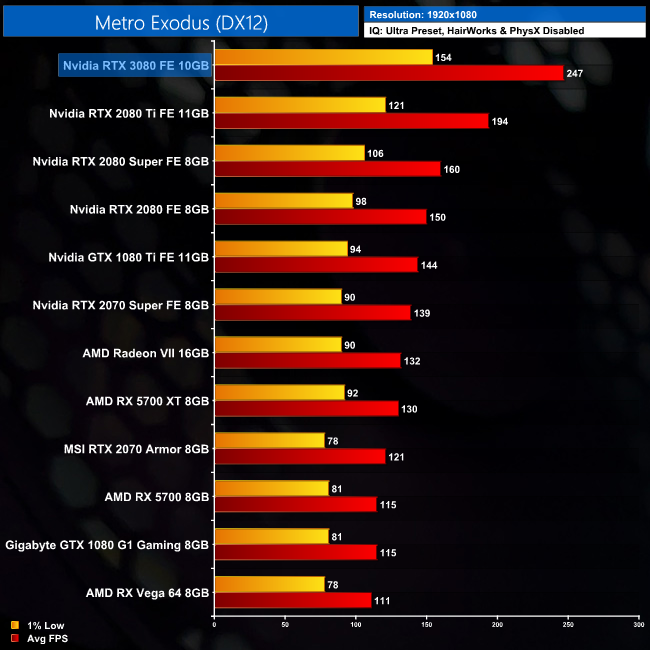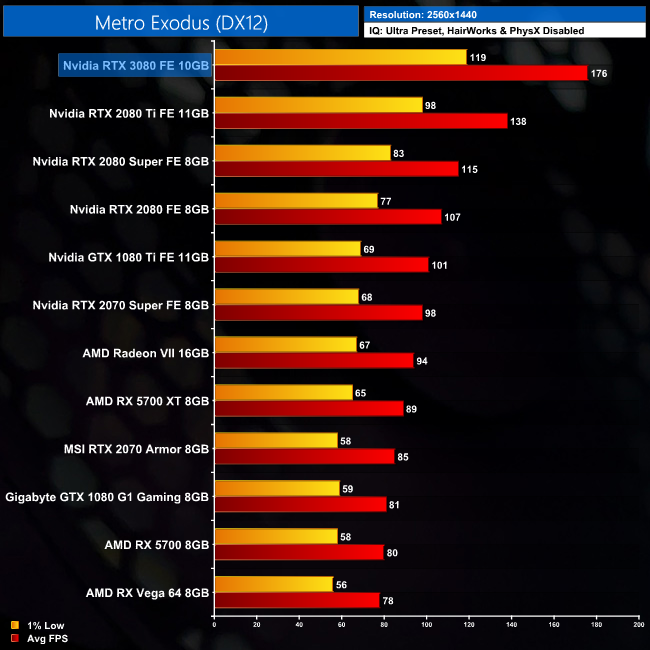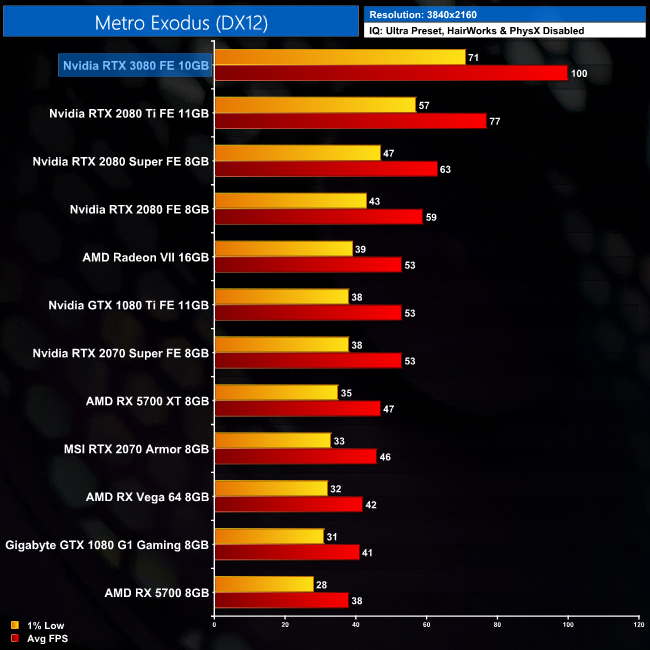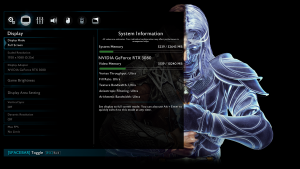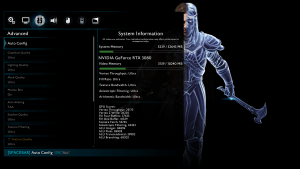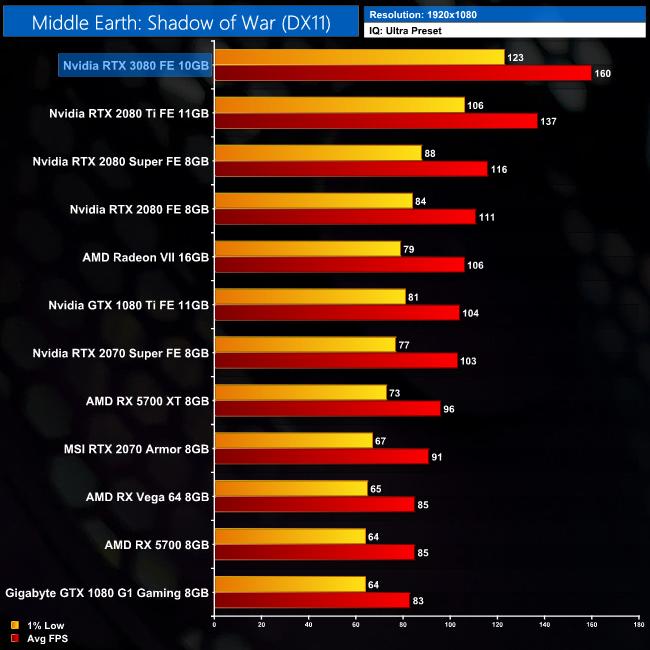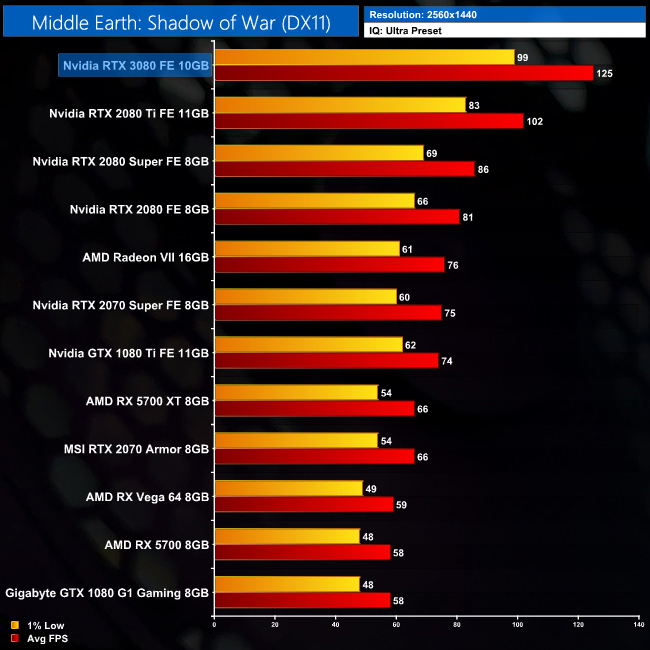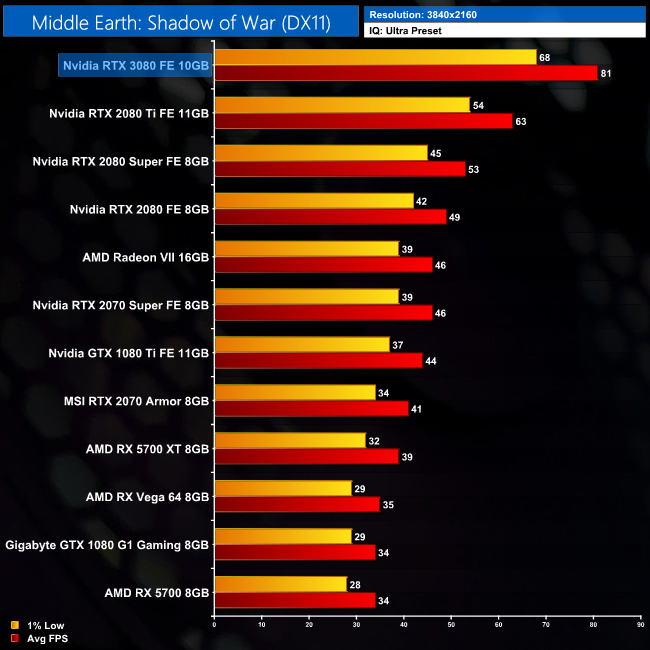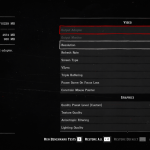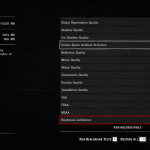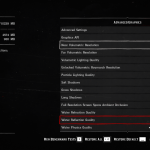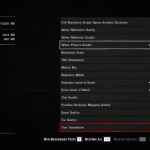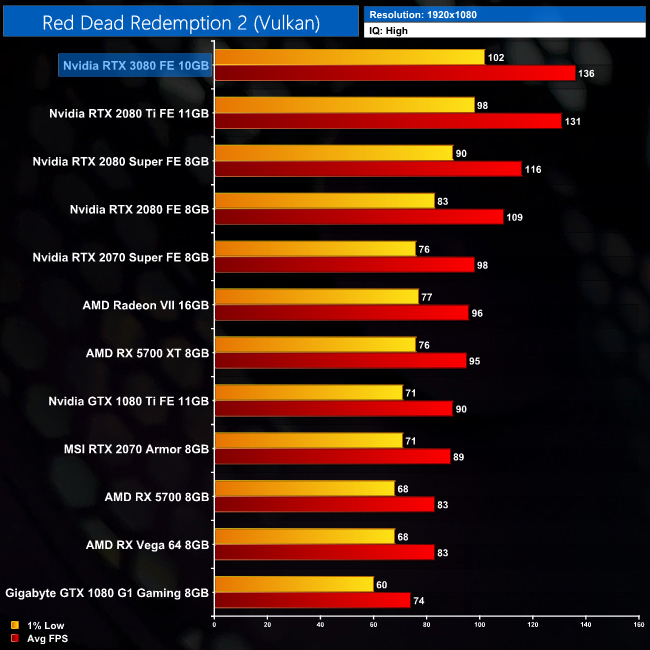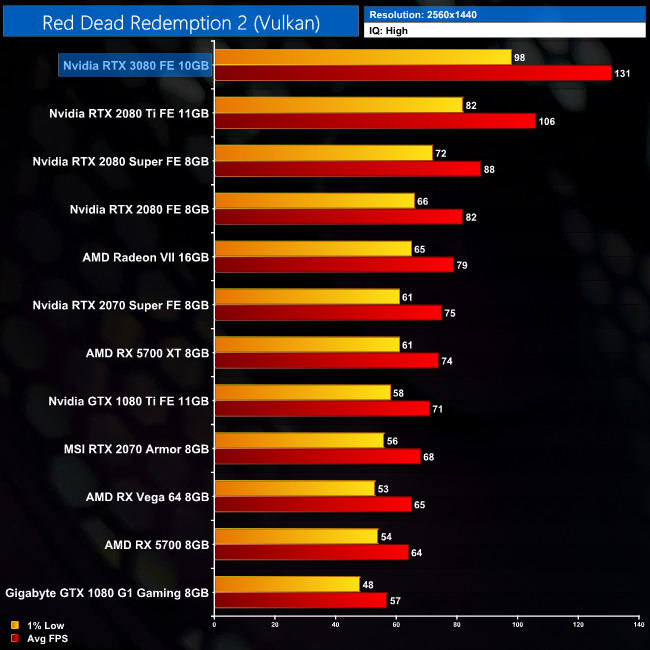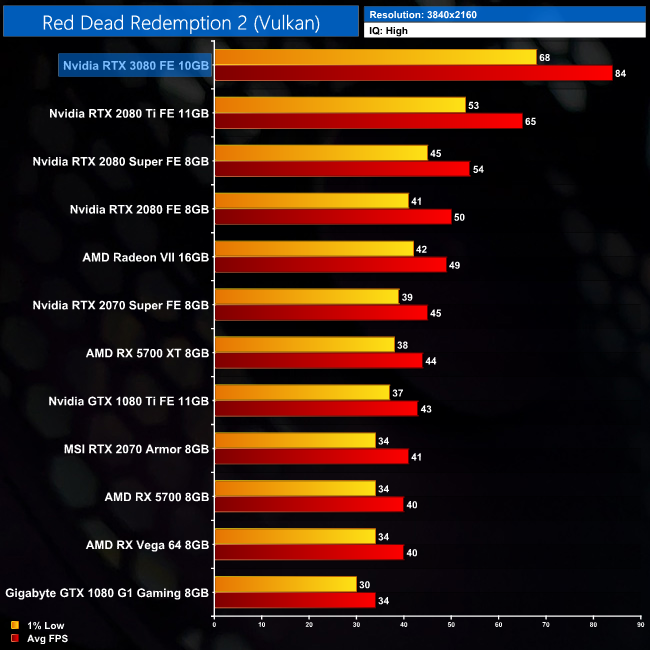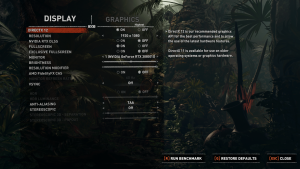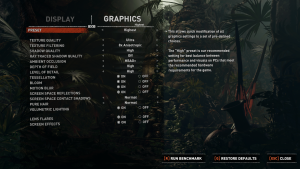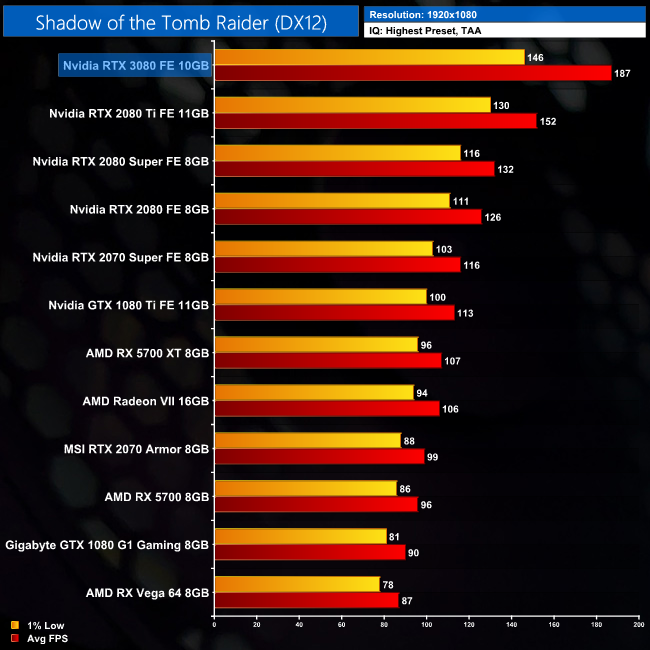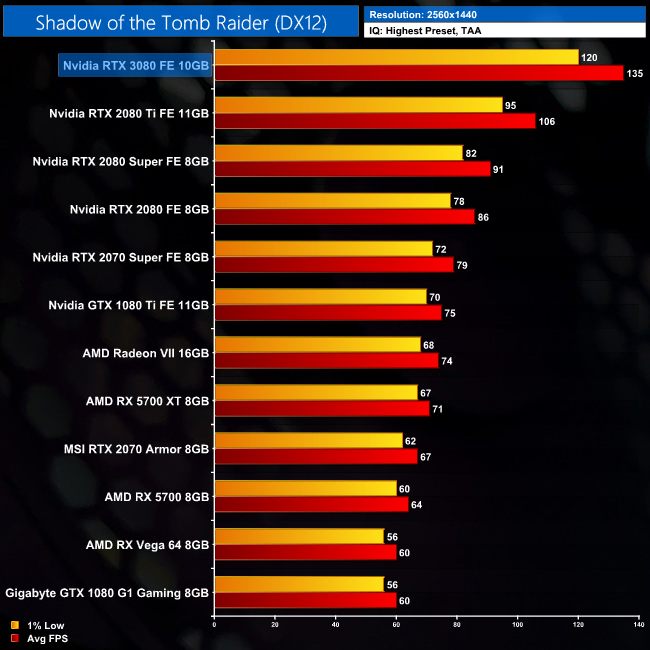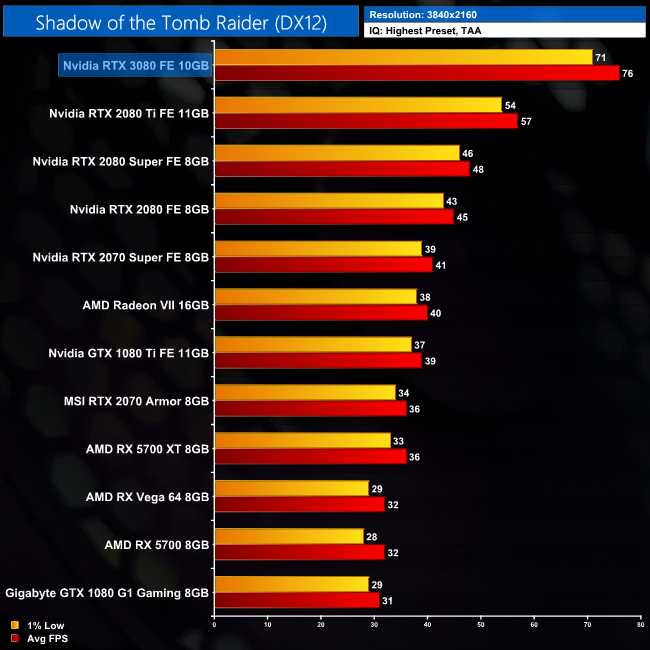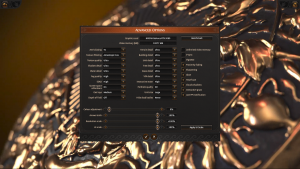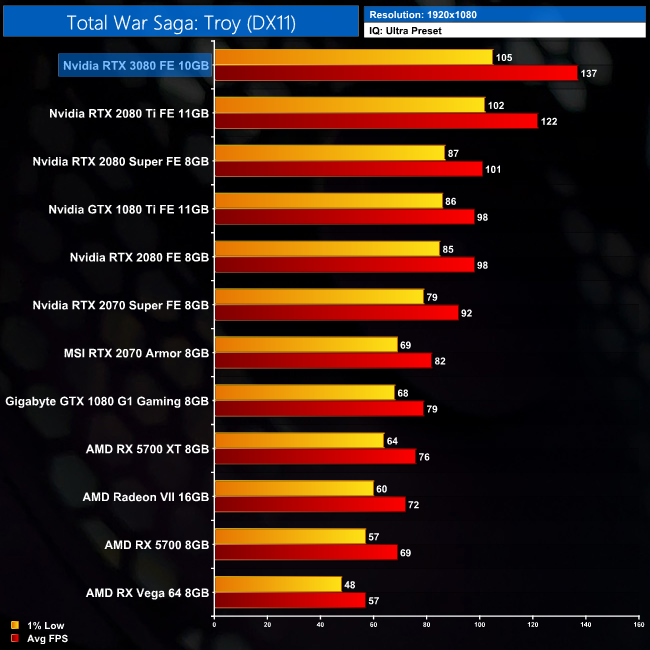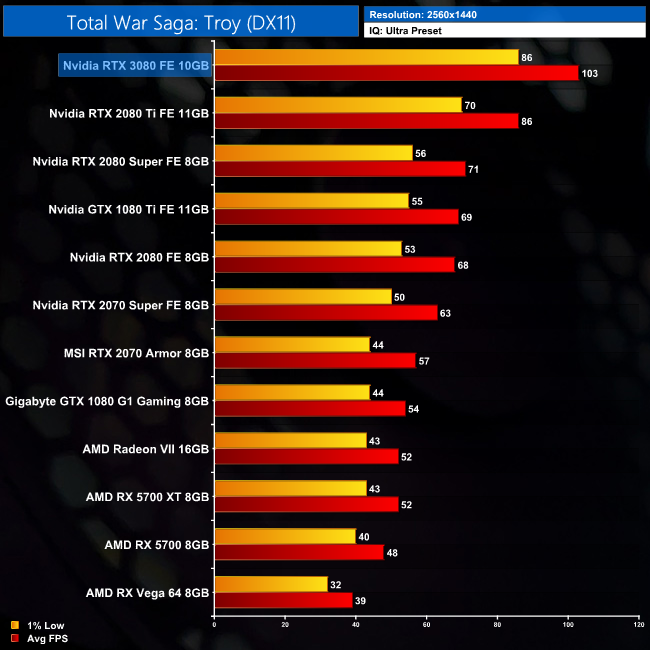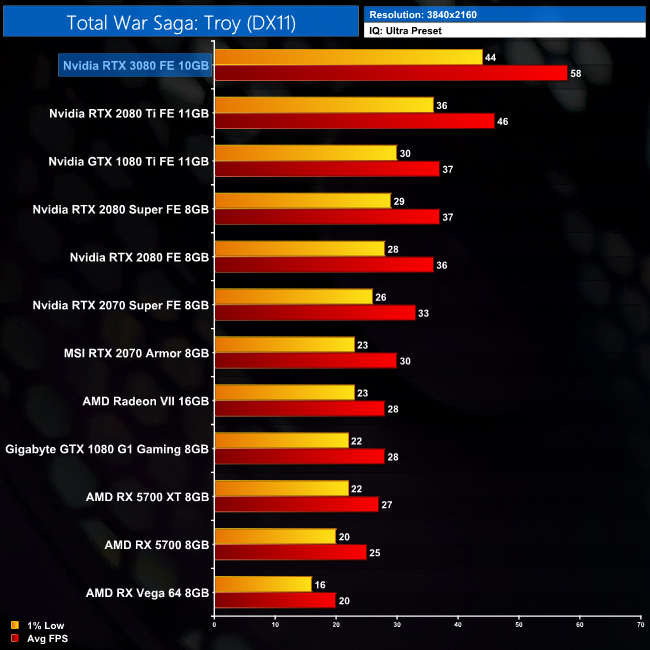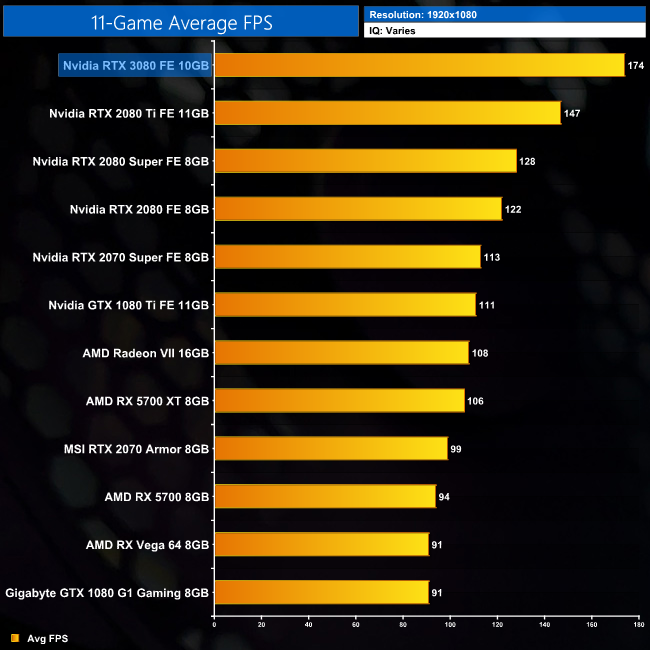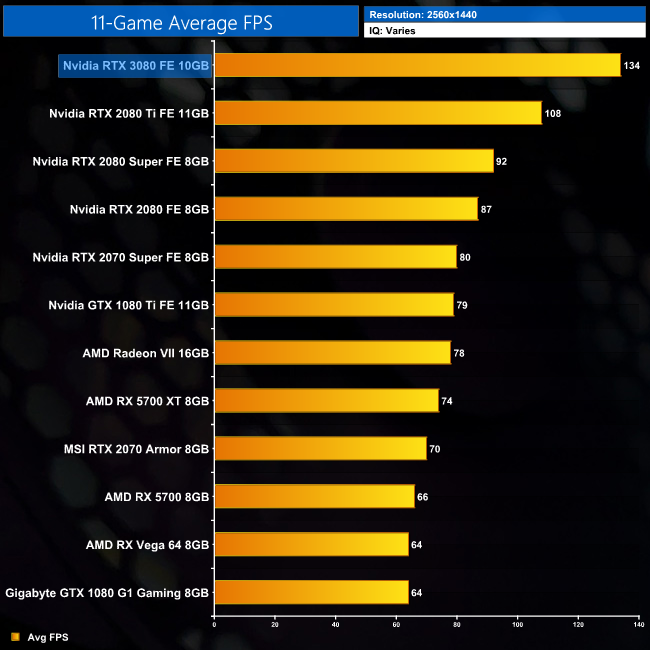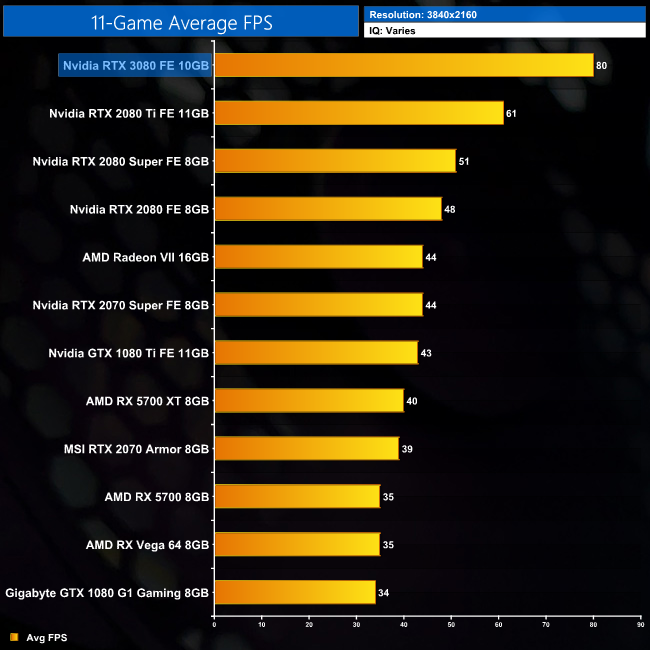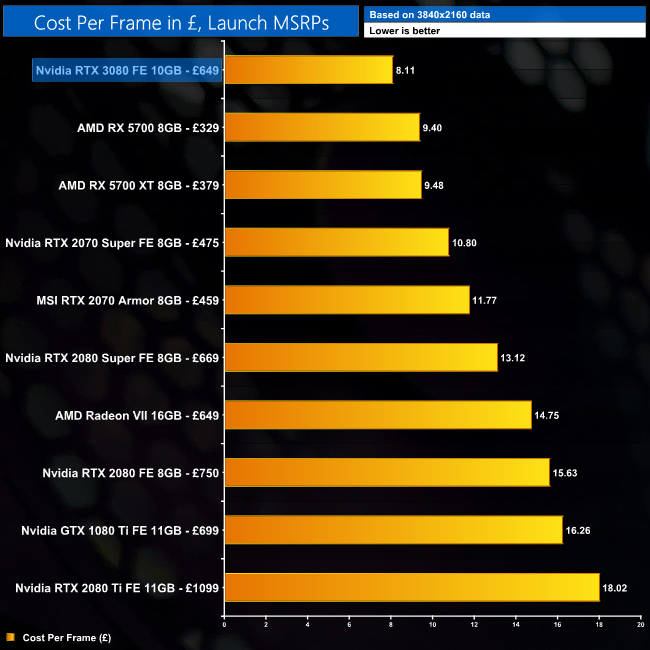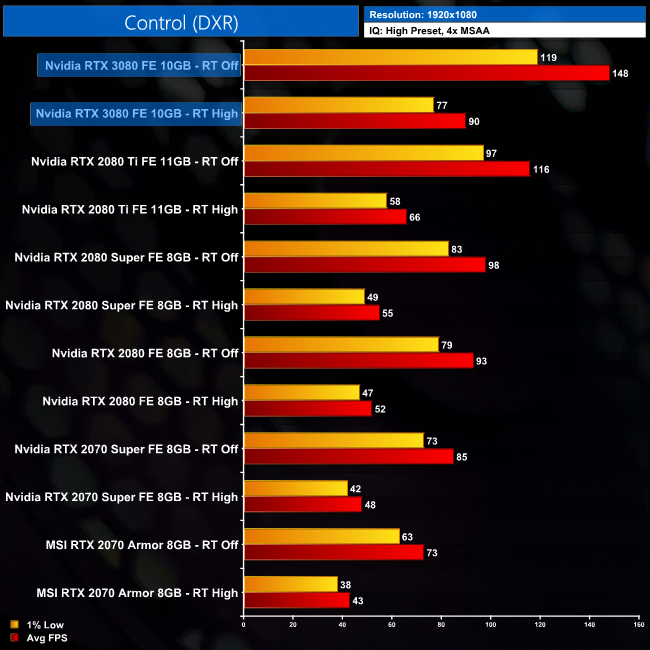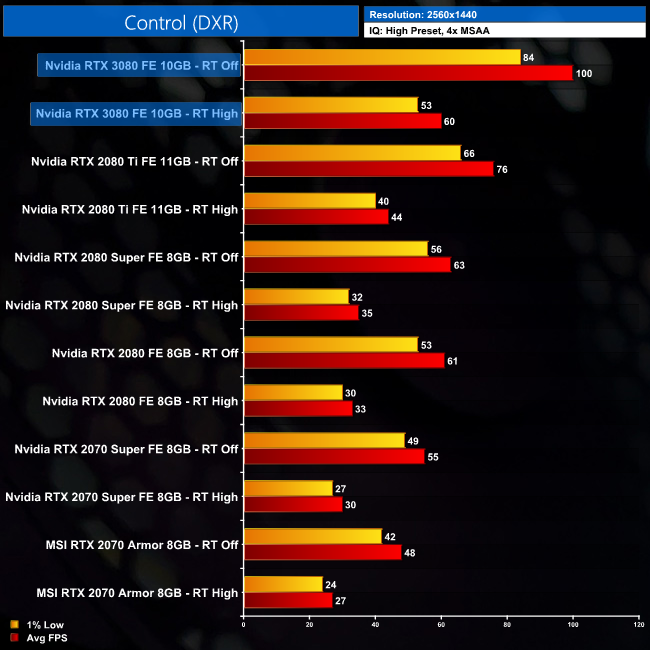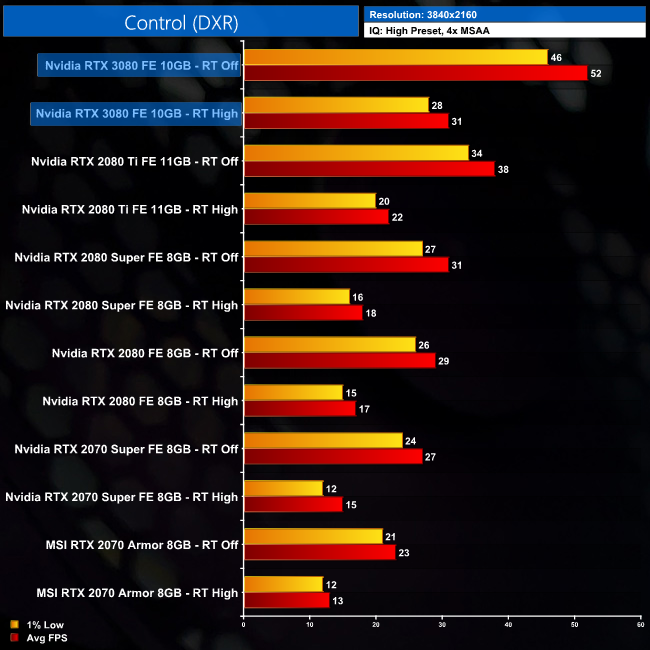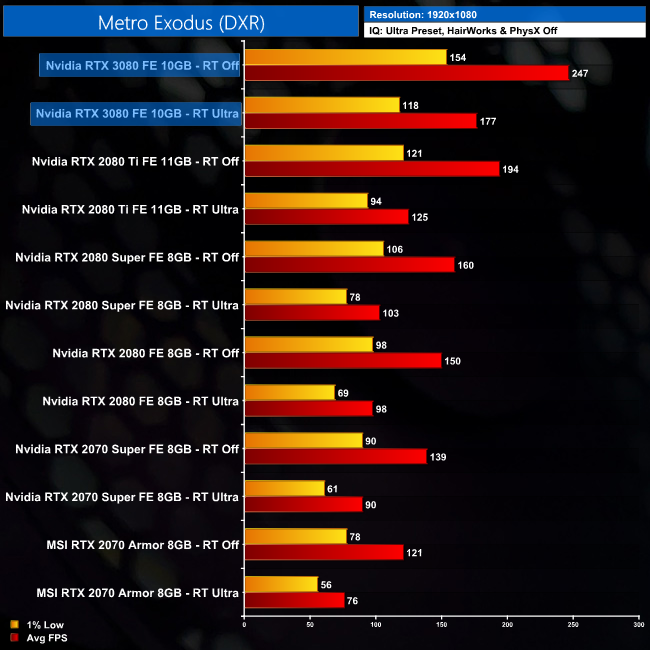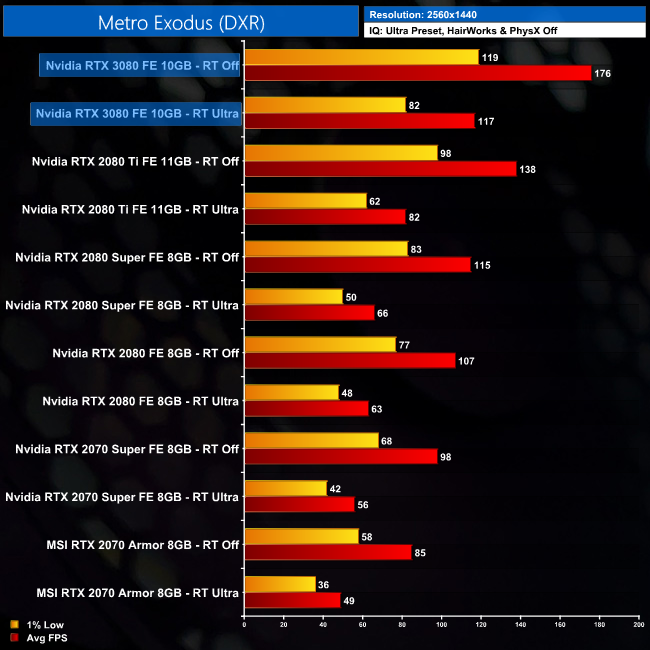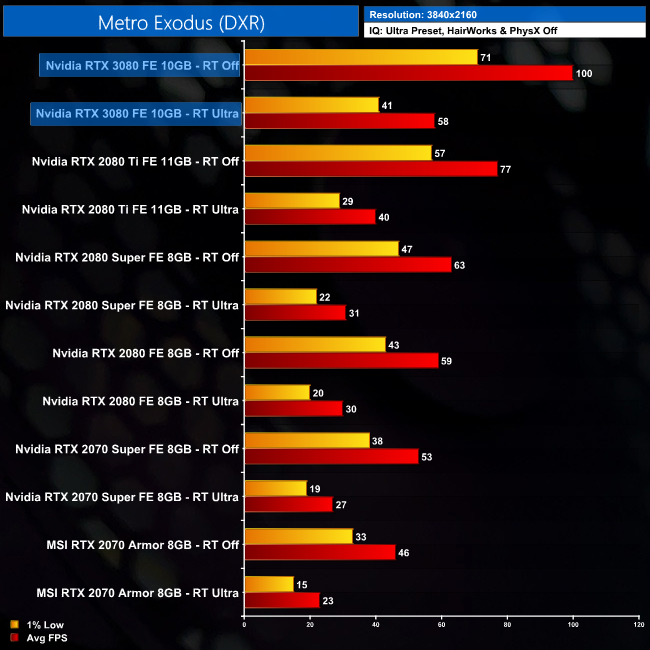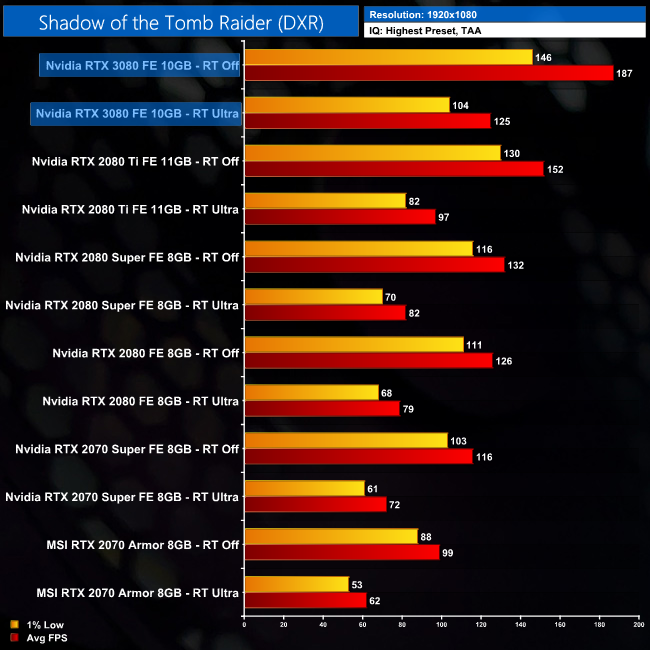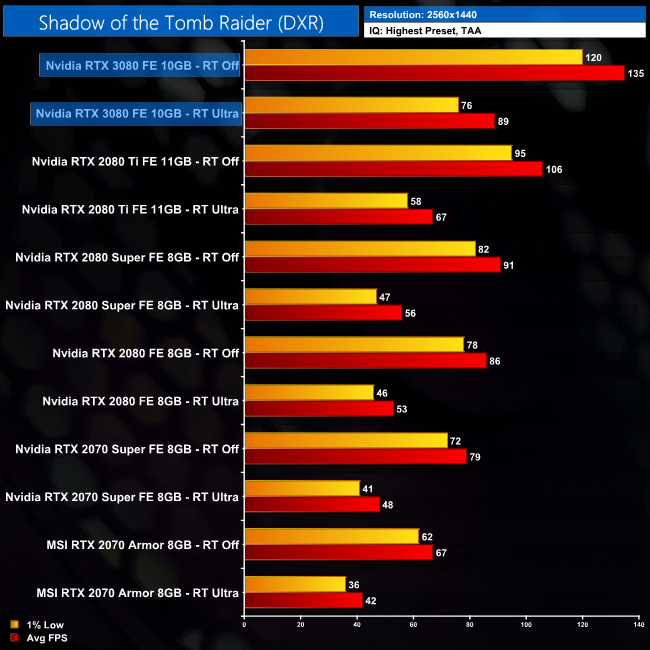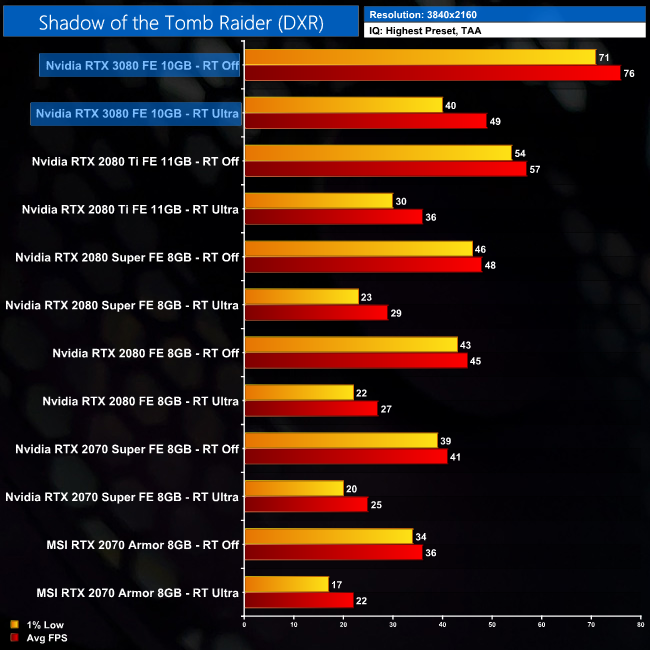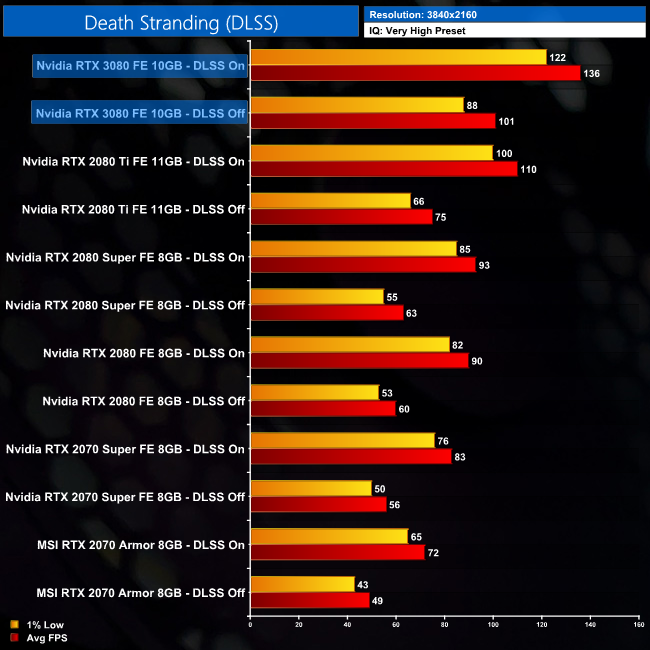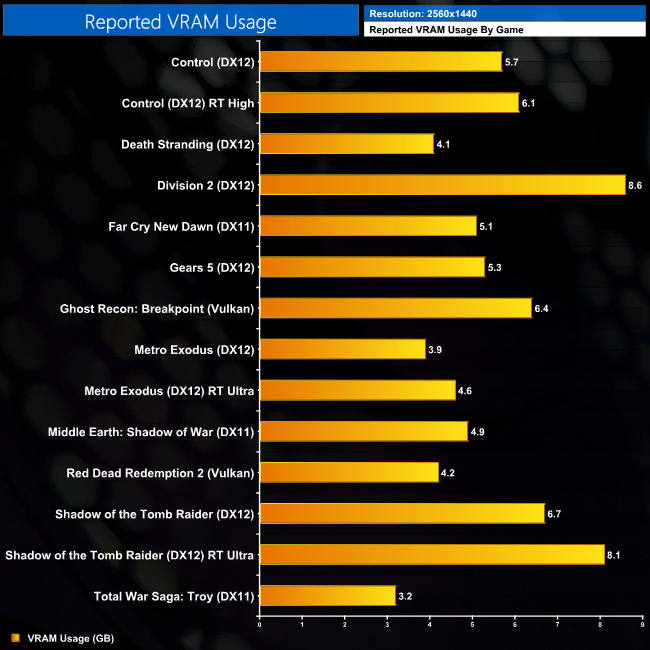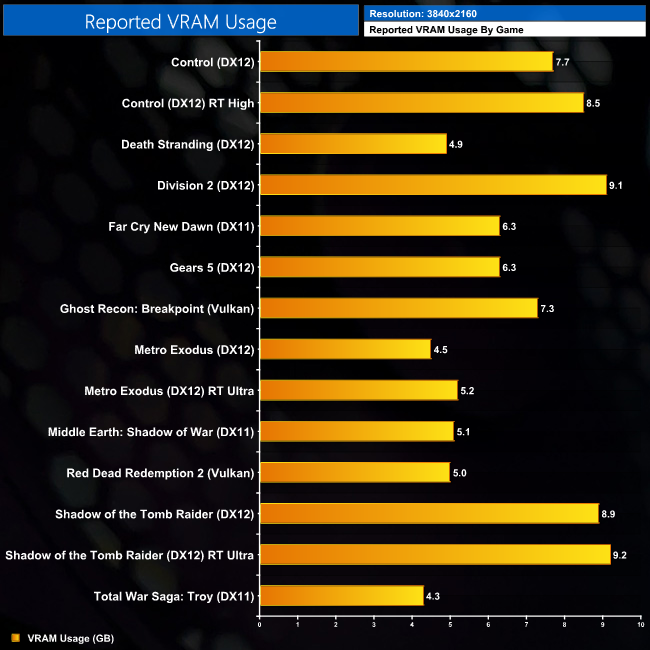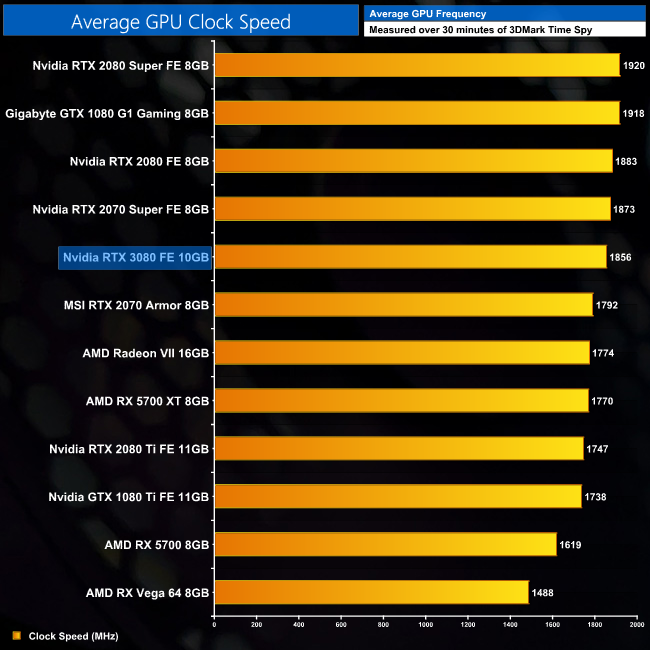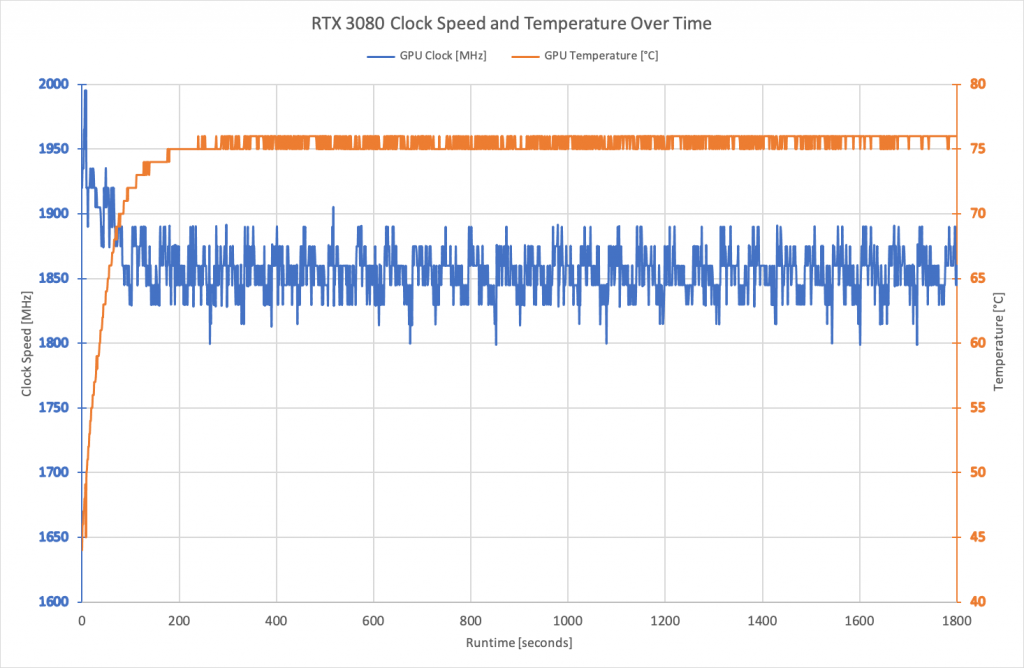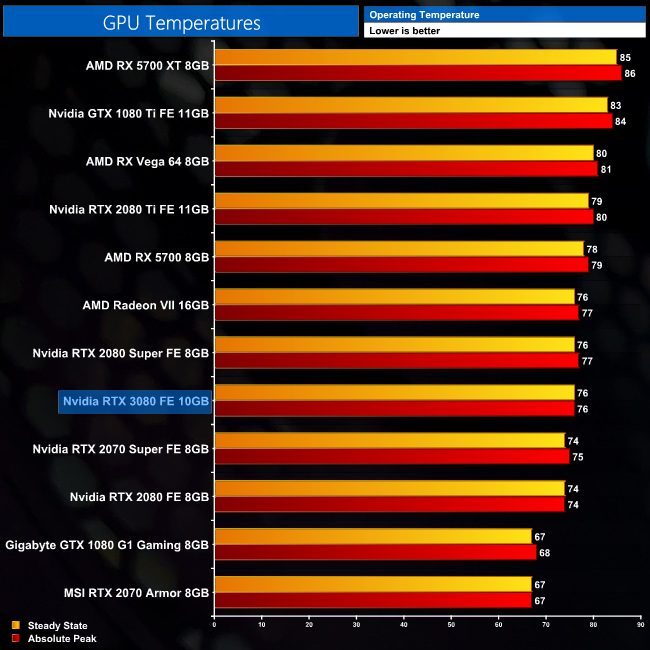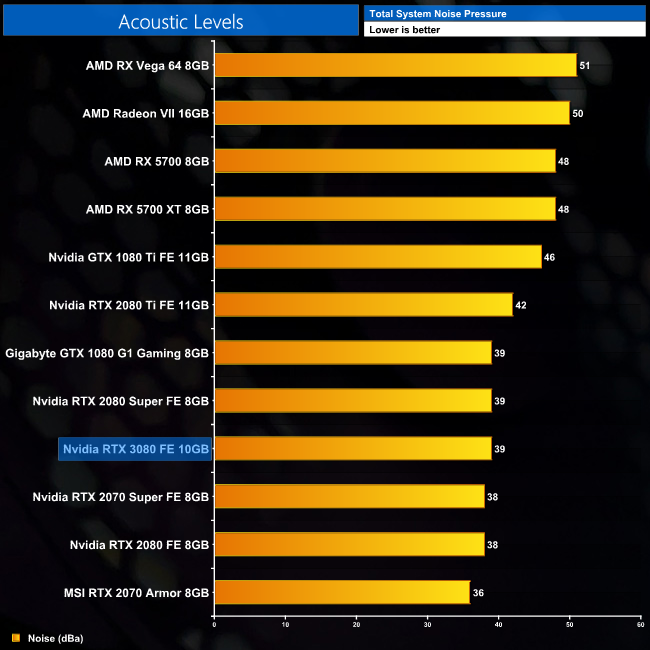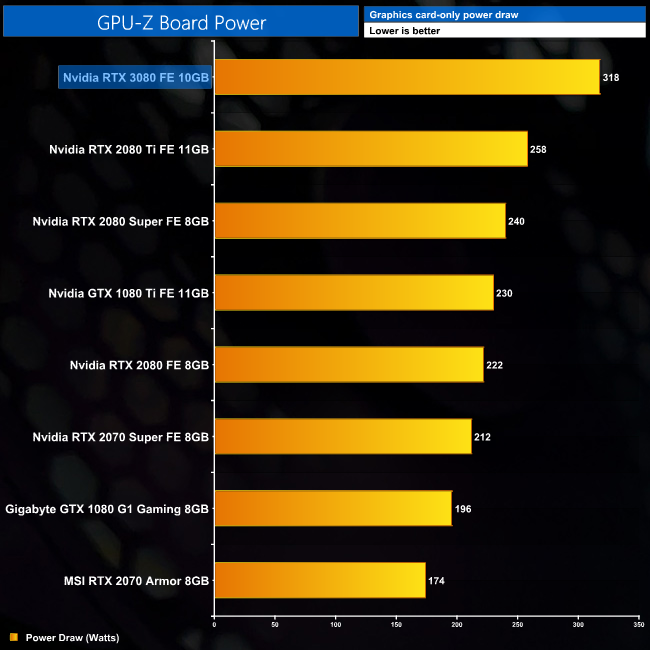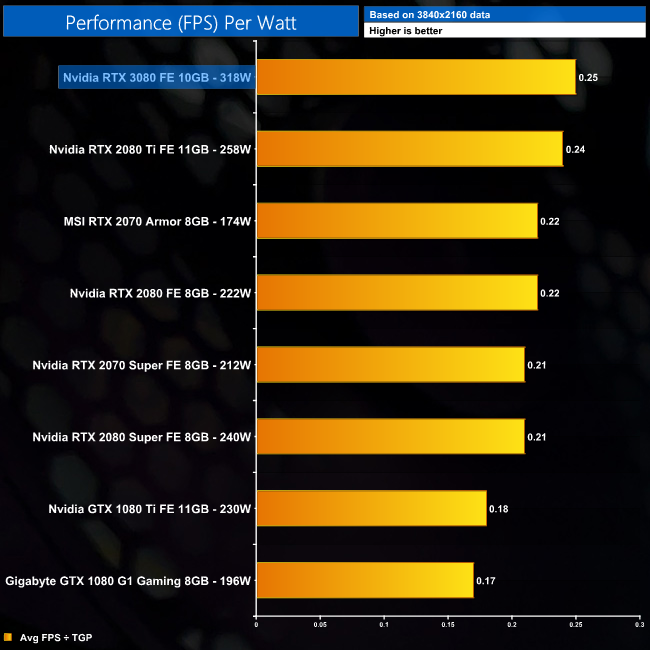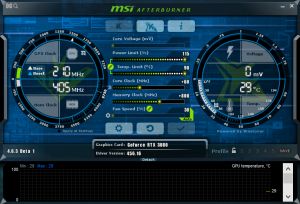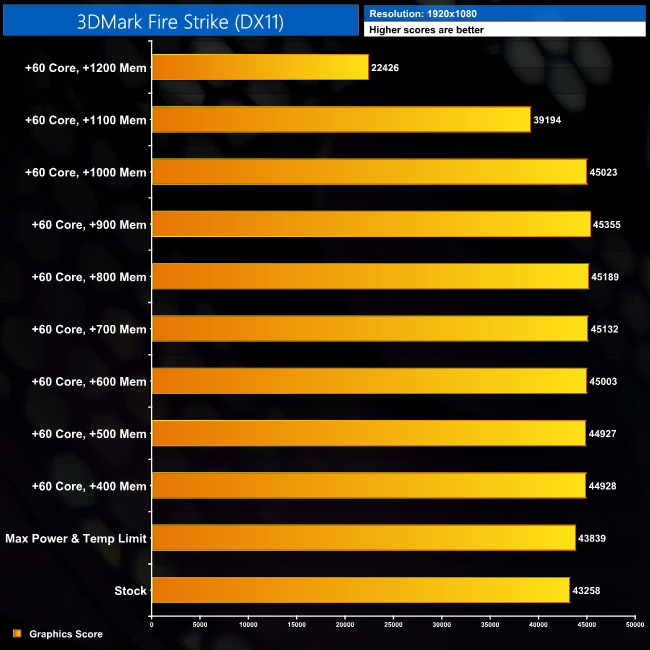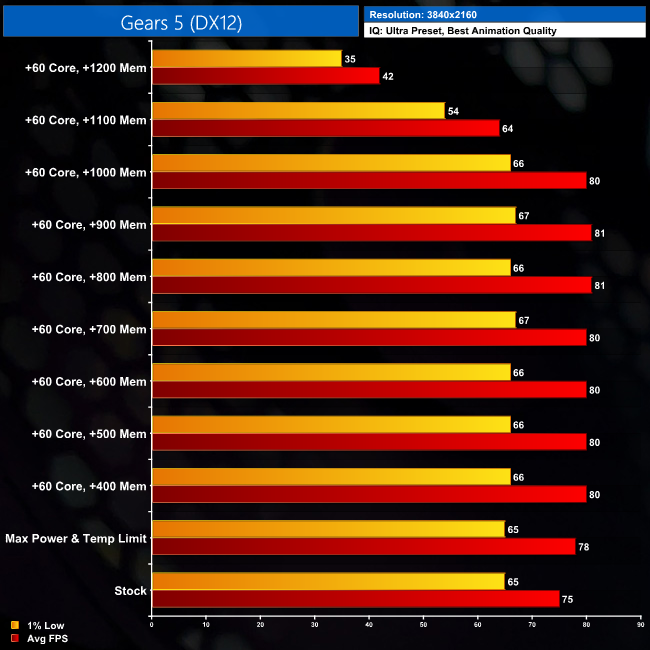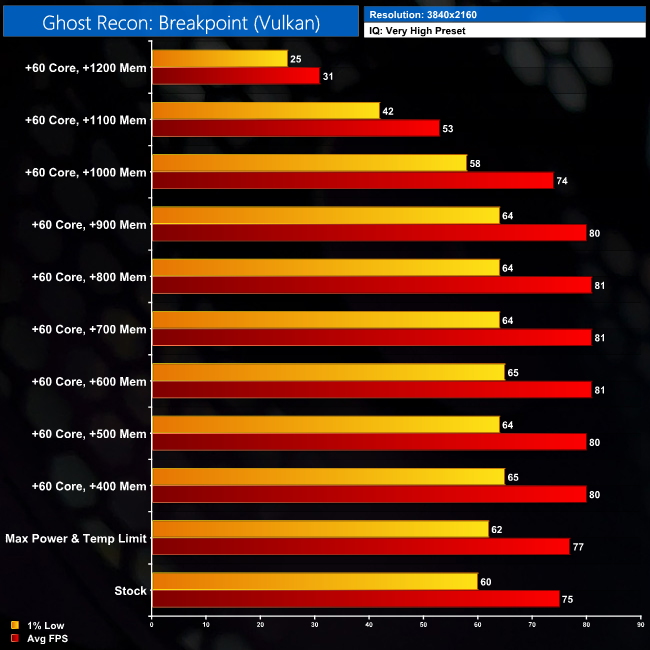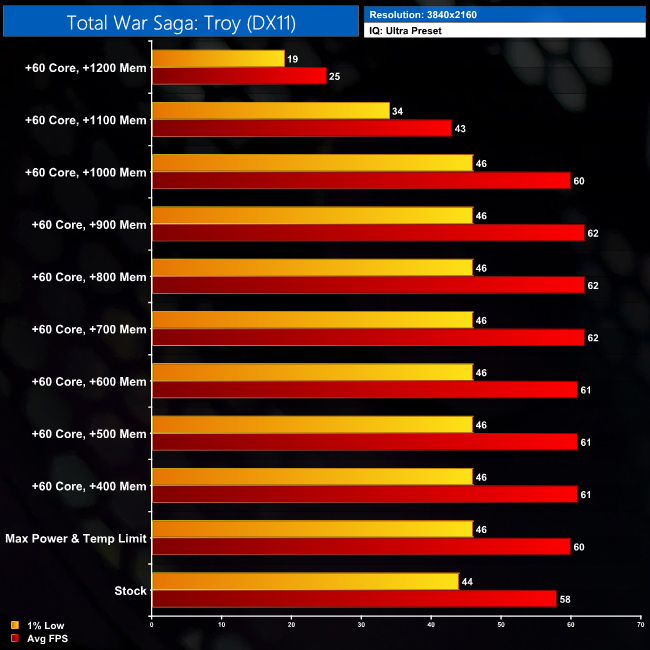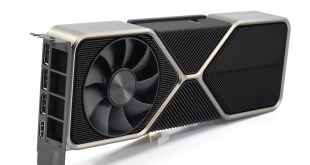
The time has come. Two years on from the launch of Turing and the RTX 20-series GPUs, Nvidia's Ampere architecture is here and so is the RTX 30-series. Promising the ‘greatest generational leap' in terms of performance, Nvidia claims the new RTX 3080 is up to twice as fast the RTX 2080, thanks to its 28 billion transistors, 8704 CUDA Cores and 10GB of new GDDR6X memory. Just how fast is this GPU – really?
| GPU | RTX 3090 | RTX 3080 | RTX 2080 Ti (FE) | RTX 2080 SUPER | RTX 2080 (FE) |
| SMs | 82 | 68 | 68 | 48 | 46 |
| CUDA Cores | 10496 | 8704 | 4352 | 3072 | 2944 |
| Tensor Cores | 328 | 272 | 544 | 384 | 368 |
| RT Cores | 82 | 68 | 68 | 48 | 46 |
| Texture Units | 328 | 272 | 272 | 192 | 184 |
| ROPs | 112 | 96 | 88 | 64 | 64 |
| GPU Boost Clock | 1695 MHz | 1710 MHz | 1635 MHz | 1815 MHz | 1800 MHz |
| Memory Data Rate | 19.5 Gbps | 19 Gbps | 14 Gbps | 15.5 Gbps | 14 Gbps |
| Total Video Memory | 24GB GDDR6X | 10GB GDDR6X | 11GB GDDR6 | 8GB GDDR6 | 8GB GDDR6 |
| Memory Interface | 384-bit | 320-bit | 352-bit | 256-bit | 256-bit |
| Memory Bandwidth | 936 GB/Sec | 760 GB/Sec | 616 GB/sec | 496.1 GB/sec | 448 GB/sec |
| TGP | 350W | 320W | 260W | 250W | 225W |
It is safe to say the RTX 20-series never really captivated the gaming audience as Nvidia intended. Despite the Turing architecture bringing support for hardware-accelerated ray tracing and the AI-driven Deep Learning Super Sampling (DLSS) technology, the relatively meagre gains in terms of traditional raster performance – coupled with increased pricing compared to the 10-series – meant many gamers held onto their Pascal GPUs (or older) instead of upgrading.
With Ampere, Nvidia is addressing the problem head-on. Core counts have been massively increased across the board, with the RTX 3090 boasting an astonishing 10496 CUDA cores, while the RTX 3080 comes in with 8704. Memory has also been upgraded in the form of Micron's new GDDR6X which, coupled with a wider 320-bit memory interface, delivers almost 70% higher memory bandwidth than the RTX 2080. Thanks to a move to Samsung's 8nm node, the RTX 3080 GPU also features an eye-watering 28 billion transistors.
The company is also pushing on with its RTX features, claiming significantly improved RT and Tensor core performance compared to Turing. It's safe to say the reception to RTX technology as a whole was pretty chilly, but with DLSS 2.0 launching in April, and Nvidia's 2nd Gen RT cores supposedly bringing twice the throughput of the first-gen cores, Ampere could be the coming out party for RTX.
All of these improvements come with increased power draw, despite Nvidia moving from TSMC's 12nm process to Samsung's 8nm process node with the 30-series. Total graphics power, or TGP – the power consumption of the entire card – is now up to 320W for the RTX 3080, a 28% increase over last generation's flagship, the RTX 2080 Ti. Despite that, we can also note clock speeds have been slightly reduced compared to the 20-series, with the RTX 3080 sporting a boost clock of 1710MHz, down from the 1815MHz clock of the RTX 2080 Super.
Ampere brings with it several key changes in terms of the GPU architecture. Here we go over what you need to know.
The New SM
Click to enlarge.
One of the headline-grabbing features of the RTX 30-series has been the ludicrously high core counts. Considering the RTX 2080 Ti launched with 4352 CUDA Cores, and that was the most populous of the 20-series GeForce stack, it was pretty astonishing to see even the RTX 3070 exceed that, while the RTX 3080 has double the cores.
This is a result of Nvidia doubling the number of FP32 ALUs per SM. Where Turing had a dedicated data path for INT operations, with Ampere this is now split between INT and FP32. Tony Tamasi, VP of Technical Marketing at Nvidia, explained this change as part of a Q&A on reddit:
“One of the key design goals for the Ampere 30-series SM was to achieve twice the throughput for FP32 operations compared to the Turing SM. To accomplish this goal, the Ampere SM includes new datapath designs for FP32 and INT32 operations. One datapath in each partition consists of 16 FP32 CUDA Cores capable of executing 16 FP32 operations per clock. Another datapath consists of both 16 FP32 CUDA Cores and 16 INT32 Cores. As a result of this new design, each Ampere SM partition is capable of executing either 32 FP32 operations per clock, or 16 FP32 and 16 INT32 operations per clock. All four SM partitions combined can execute 128 FP32 operations per clock, which is double the FP32 rate of the Turing SM, or 64 FP32 and 64 INT32 operations per clock.
Doubling the processing speed for FP32 improves performance for a number of common graphics and compute operations and algorithms. Modern shader workloads typically have a mixture of FP32 arithmetic instructions such as FFMA, floating point additions (FADD), or floating point multiplications (FMUL), combined with simpler instructions such as integer adds for addressing and fetching data, floating point compare, or min/max for processing results, etc. Performance gains will vary at the shader and application level depending on the mix of instructions. Ray tracing denoising shaders are good examples that might benefit greatly from doubling FP32 throughput.
Doubling math throughput required doubling the data paths supporting it, which is why the Ampere SM also doubled the shared memory and L1 cache performance for the SM. (128 bytes/clock per Ampere SM versus 64 bytes/clock in Turing). Total L1 bandwidth for GeForce RTX 3080 is 219 GB/sec versus 116 GB/sec for GeForce RTX 2080 Super.
Like prior NVIDIA GPUs, Ampere is composed of Graphics Processing Clusters (GPCs), Texture Processing Clusters (TPCs), Streaming Multiprocessors (SMs), Raster Operators (ROPS), and memory controllers.
The GPC is the dominant high-level hardware block with all of the key graphics processing units residing inside the GPC. Each GPC includes a dedicated Raster Engine, and now also includes two ROP partitions (each partition containing eight ROP units), which is a new feature for NVIDIA Ampere Architecture GA10x GPUs. More details on the NVIDIA Ampere architecture can be found in NVIDIA’s Ampere Architecture White Paper, which will be published in the coming days.”
GDDR6X Memory
Another step forward is the use of GDDR6X memory with the RTX 3080 and RTX 3090, though the RTX 3070 will remain on GDDR6. Developed in collaboration with Micron, GDDR6X uses new 4-level Pulse Amplitude Modulation (PAM4) signalling instead of the previous 2-level NRZ signalling that is used with GDDR6 (non-X). Where NRZ signalling can only send binary data, PAM4 – as the name suggests – can send one of our voltage levels, in steps of 250 mV, per clock cycle. Nvidia claims this allows GDDR6X to ‘transmit twice as much data as GDDR6' memory.
RTX 3080 sports 10GB of GDDR6X, clocked at 19Gbps. Coupled with the 320-bit memory interface, memory bandwidth is up to 760 GB/s, while the RTX 3090 is capable of hitting bandwidth speeds of 936 GB/s.
Additionally, Nvidia has changed how the memory responds to overclocking – as we will see later in the review. Based on my experience overclocking the RTX 3080, I got in touch with Nvidia about this as they responded with the following:
“One of the design features we added to enhance memory reliability is transaction error detection and replay. That is, when the encoding shows that there has been a data transmission error, the transmission in error is re-tried or “replayed” until a correct memory transaction is successful. As you push overclocks and cause more errors, the re-tried transactions reduce useful memory bandwidth and thus reduces performance.
This feature actually increases memory frequency capability and pushes out the artifacts, crashes, and other negative impacts of overclocking to higher frequencies. Crashes can still happen if frequencies are pushed too hard. So, if performance starts dropping, you've actually passed the limit at which the system would have crashed. Rather than rebooting as feedback, plateauing performance indicates you’ve hit the limits of OC.”
RT and Tensor Improvements
Alongside improvements to the Tensor Cores and RT cores themselves, Nvidia has also introduced what it calls Second Generation Concurrency. With Turing, the GPU was limited to executing the shader and RT pipelines concurrently, while any DLSS (Tensor) workloads had to come further down the pipeline. With Ampere, it is now possible to execute shader, RT and DLSS operations concurrently, improving performance to the end user.
Using Wolfenstein Youngblood as an example, if Ampere tried to render a ray traced frame through software, without using the RT or Tensor cores, Nvidia claims we would be looking at a frame time of 37ms, or about 27fps. Thanks to the RT cores, ray tracing is significantly easier to run than through software, so the frametime can be reduced to 11ms. Once DLSS is added to the workload via the Tensor core, the render time is further reduced to a 7.5ms frametime. Nvidia claims that executing all three operations concurrently, however, will improve performance further, with a frametime of 6.7ms, or 149fps.
RTX IO
The last key feature we want to touch on here is RTX IO. Nvidia explains this by pointing to the ever-increasing speeds of SSDs, which are now wildly faster than traditional HDDs. The increased speeds, however, run into bottlenecks with the traditional I/O subsystems, which is why developers have been turning to lossless compression techniques. Nvidia claims that such techniques performed with a PCIe Gen4 SSD can utilise ‘tens of CPU cores', limiting I/O performance and impacting ‘next-generation streaming systems that large, open-world games need.'
The solution is RTX IO. This is a new API that aims to deliver GPU-based lossless decompression, moving work from the CPU and to the GPU which, Nvidia claims, can provide ‘enough decompression horsepower to support even multiple Gen4 SSDs. This can enable I/O rates more than 100 times that of traditional hard drives, and reduce CPU utilisation by 20x.'
The kicker is that RTX IO does need specific integration into games by the developers, so we can't just take an RTX card and speed things up in any old game. However, Nvidia says it is working with Microsoft to ensure RTX IO is cooperative with DirectStorage, as by using DirectStorage, ‘next-gen games will be able to take full advantage of their RTX IO enabled hardware to accelerate load times and deliver larger open worlds, all while reducing CPU load.'
The RTX 3080 Founders Edition ships in a new style of box that is largely black, but with some silver accents. The Nvidia logo sits in the top left corner, just above the GeForce RTX branding.
The top of the box (slowly) lifts off to reveal the back of the card, and it does make an excellent first impression – but more on that below.
Underneath the graphics card itself, a small box contains all the included accessories, consisting of a couple of guides and that 2x 8-pin to 12-pin power adapter we looked at in our unboxing.
As for the Founders Edition, in my view this is far and away the best-looking graphics card Nvidia has ever designed. It has a somewhat industrial look to it, with the black heatsink fins and thick metal unibody frame, creating a lovely contrast.
The outer frame, a sort of gunmetal colour, also crosses in a x-pattern through the centre of the card. It's worth noting the card measures 285mm long, and it's 112mm wide, with a standard dual-slot thickness. This means it's almost 20mm longer than the 20-series Founders cards, but it should still fit in most ATX cases.
Of course, the fan layout has been radically overhauled, with one 85mm on the underside of the card pushing air through the heatsink and straight out of the case via the I/O bracket. The fan on the top of the card, next to the backplate, pulls air through the heatsink and exhausts it out into the CPU/memory area of the motherboard/chassis, where the system's exhaust fans can expel the heat.
Speaking of the back of the card, this features the RTX 3080 branding printed towards the I/O bracket, with the fan taking up the right-hand side. It's all very tastefully done, with nothing looking out of place. Even the screws are hidden under small tabs, giving the card a very polished look.
The 12-pin power connector is of course a hot topic, Nvidia claims it opted for this new standard purely as a space-saving measure, though they also say the 12-pin can deliver more power than 2x 8-pins. As the RTX 3080 is a 320W card that isn't strictly necessary just yet, but perhaps GPUs in years to come will continue to increase their rated power draw. For now, the included adapter will get the job done, but it seems every PSU manufacturer is at least working on their own modular 12-pin cables for a neater solution.
For display outputs, RIP to the USB-C VirtualLink connector… but we have 3x DisplayPort 1.4a ports and then, crucially, HDMI 2.1 capable of the full 48Gbps bandwidth. Display Stream Compression is also supported, so you could even use this port for 8K/60Hz output with HDR enabled.
PCB and cooler images courtesy of Nvidia.
Lastly we come to the PCB and cooler. Please note – I have not disassembled the Founders Edition card that Nvidia sampled us with, the above images are stock photos provided by Nvidia directly.
Even so, the triangular PCB is highly unusual, but don't fret – it is exclusive to Nvidia's Founders Edition card, and isn't the reference design. AIB partners like Gigabyte, ASUS, MSI etc will be using traditional rectangular PCBs. Though I would like to see EKWB come up with a triangular waterblock….
Everything on the PCB is so tightly placed, Nvidia tells us it was really trying to remove as much obstruction to the airflow as possible, hence the new design and triangular cutout. What we can see is a total of 18 power stages, 15 for the GPU and 3 for the memory, while we know the 10GB GDDR6X is manufactured by Micron.
The cooler uses a hybrid approach, with a vapour chamber plate contacting the GPU die, with four heatpipes transferring the heat from that chamber out into the fin array, which is then dissipated by the airflow from the two fans. It makes complete sense on paper, but we test cooling and noise levels later in the review.
Driver Notes
- All Nvidia GPUs (except RTX 3000) were benchmarked with the 452.06 driver.
- RTX 3080 was benchmarked with the 456.16 driver supplied to press.
- All AMD GPUs were benchmarked with the Adrenalin 20.8.2 driver.
Test System
We test using the a custom built system from PCSpecialist, based on Intel's latest Comet Lake-S platform. You can read more about it over HERE, and configure your own system from PCSpecialist HERE.
| CPU |
Intel Core i9-10900K
Overclocked to 5.1GHz on all cores |
| Motherboard |
ASUS ROG Maximus XII Hero Wi-Fi
|
| Memory |
Corsair Vengeance DDR4 3600MHz (4 X 8GB)
CL 18-22-22-42
|
| Graphics Card |
Varies
|
| System Drive |
500GB Samsung 970 Evo Plus M.2
|
| Games Drive | 2TB Samsung 860 QVO 2.5″ SSD |
| Chassis | Fractal Meshify S2 Blackout Tempered Glass |
| CPU Cooler |
Corsair H115i RGB Platinum Hydro Series
|
| Power Supply |
Corsair 1200W HX Series Modular 80 Plus Platinum
|
| Operating System |
Windows 10 2004
|
Comparison Graphics Cards List
- Nvidia RTX 2080 Ti FE 11GB
- Nvidia RTX 2080 Super FE 8GB
- Nvidia RTX 2080 FE 8GB
- Nvidia RTX 2070 Super FE 8GB
- MSI RTX 2070 Armor 8GB
- Nvidia GTX 1080 Ti FE 11GB
- Gigabyte GTX 1080 G1 Gaming 8GB
- AMD Radeon VII 16GB
- AMD RX 5700 XT 8GB
- AMD RX 5700 8GB
- AMD RX Vega 64 8GB
Software and Games List
- 3DMark Fire Strike & Fire Strike Ultra (DX11 Synthetic)
- 3DMark Time Spy (DX12 Synthetic)
- 3DMark Port Royal (DXR Synthetic)
- Control (DX12)
- Death Stranding (DX12)
- The Division 2 (DX12)
- Far Cry New Dawn (DX11)
- Gears 5 (DX12)
- Ghost Recon: Breakpoint (Vulkan)
- Metro: Exodus (DX12)
- Middle Earth: Shadow of War (DX11)
- Red Dead Redemption 2 (Vulkan)
- Shadow of the Tomb Raider (DX12)
- Total War Saga: Troy (DX11)
We run each benchmark/game three times, and present mean averages in our graphs. We use OCAT to measure average frame rates as well as 1% low values across our three runs.
3DMark Fire Strike is a showcase DirectX 11 benchmark designed for today’s high-performance gaming PCs. It is our [FutureMark’s] most ambitious and technical benchmark ever, featuring real-time graphics rendered with detail and complexity far beyond what is found in other benchmarks and games today.
It's a very promising start for the RTX 3080 in our 3DMark benchmarks. In Fire Strike, it's graphics score is 23% higher than the RTX 2080 Ti, while that increases to 55% when compared to the RTX 2080.
Time Spy sees those leads increased, to 26% and 62% respectively, but it's the 4K Fire Strike Ultra benchmark where we see this card's best performance, delivering a graphics score 34% higher than the 2080 Ti. Not bad at all!3DMark Port Royal is the world’s first dedicated real-time ray tracing benchmark for gamers. You can use Port Royal to test and compare the real-time ray tracing performance of any graphics card that supports Microsoft DirectX Raytracing. As well as benchmarking performance, 3DMark Port Royal provides a realistic and practical example of what to expect from ray tracing in upcoming games.
Now we come to Port Royal, 3DMark's ray tracing benchmark. Here the relative gains for the RTX 3080 versus the RTX 2080 are even bigger than what we saw in Fire Strike or Time Spy – delivering 73% increased performance. Compared to the 2080 Ti, it's 31% faster.
Control is an action-adventure video game developed by Remedy Entertainment and published by 505 Games. Control was released on 27 August 2019 for Microsoft Windows, PlayStation 4, and Xbox One. (Wikipedia).
Engine: Northlight Engine. We test using the High preset, with 4x MSAA, DX12 API.
Our first game of the day is Remedy's Control, arguably the game with the best RTX implementation over the last two years, and among the first to feature DLSS 2.0.
The RTX 3080 dishes out some significant beatings to the 20-series in this title, outperforming the RTX 2080 by 64% at 1440p, while it is also 32% faster than the RTX 2080 Ti at the same resolution.
Up at 4K, those margins only increase in the 3080's favour – with the increase in pixel count, its lead over the 2080 Ti grows to 37%, while it is a huge 79% faster than the 2080.
Death Stranding is an action game developed by Kojima Productions. It is the first game from director Hideo Kojima and Kojima Productions after their split from Konami in 2015. It was released by Sony Interactive Entertainment for the PlayStation 4 in November 2019 and by 505 Games for Windows in July 2020. (Wikipedia).
Engine: Decima. We test using the Very High preset, with TAA, DX12 API.
Next up is Death Stranding. Frame rates are exceedingly high in this game, and the 3080 takes that to the next level. At 1440p, this Ampere GPU is 28% faster than the 2080 Ti, 50% faster than the 2080 Super, and 55% faster than the 2080.
Bumping the resolution to 4K again brings the best out of the 3080 where we see an average frame rate of over 100FPS, or a 35% increase over last generation's GeForce flagship.
Tom Clancy's The Division 2 is an online action role-playing video game developed by Massive Entertainment and published by Ubisoft. The sequel to Tom Clancy's The Division (2016), it is set in a near-future Washington, D.C. in the aftermath of a smallpox pandemic, and follows an agent of the Strategic Homeland Division as they try to rebuild the city. (Wikipedia).
Engine: Snowdrop. We test using the Ultra preset, but with V-Sync disabled, DX12 API.
Now, The Division 2 is actually the game where we saw the biggest gen-on-gen increases for the RTX 3080, which I do find slightly amusing considering it is actually an AMD title. At 1440p, the 3080 produces 141FPS on average, a huge gain of 72% over the RTX 2080, while it also works out 32% faster than the 2080 Ti.
It's at 4K where we see the biggest gains, however, as the 3080 is not far away from double the performance of the RTX 2080, producing 76FPS compared to the 42FPS we saw from the 2080. It's a hugely impressive performance leap.
Far Cry New Dawn is an action-adventure first-person shooter developed by Ubisoft Montreal and published by Ubisoft. The game is a spin-off of the Far Cry series and a narrative sequel to Far Cry 5. It was released for Microsoft Windows, PlayStation 4 and Xbox One on February 15, 2019. (Wikipedia).
Engine: Dunia 2. We test using the Ultra preset, with the HD Textures pack, DX11 API.
Far Cry New Dawn paints a different picture, but that's because this game is bottleneck city – even at 1440p we are CPU-limited with the RTX 3080, with this GPU coming in just 7% faster than the 2080 Ti, quite a lot less than the other games we've tested so far.
Even at 4K, the margins aren't as large as we have seen, or will see, from the other games on test, with the 3080 beating out the 2080 by 55%. Considering that's the smallest gen-on-gen increase of all the games we tested, I think that tells us a lot about the performance of this card…
Gears 5 is a third-person shooter video game developed by The Coalition and published by Xbox Game Studios for Microsoft Windows and Xbox One. It is the sixth instalment of the Gears of War series, and is the second Gears of War game not to be developed by Epic Games.
Engine: Unreal Engine 4. We test using the Ultra preset, with Best Animation Quality (instead of Auto), DX12 API.
Gears 5 is another AMD title, but Nvidia cards still occupy the top half of the chart. At 1440p, the RTX 3080 delivers over 120FPS on average, another 31% increase over the RTX 2080 Ti, while it's 57% ahead of the 2080.
We're really seeing the 3080 do best at 4K, and that's no different in Gears, with the card's relative performance lead over the 2080 increasing to 67% as we bump up the resolution.
Tom Clancy's Ghost Recon Breakpoint is an online tactical shooter video game developed by Ubisoft Paris and published by Ubisoft. The game was released worldwide on 4 October 2019, for Microsoft Windows, PlayStation 4 and Xbox One, (Wikipedia).
Engine: AnvilNext 2.0. We test using the Very High preset, with AA disabled, Vulkan API.
Ghost Recon: Breakpoint is another game where the 3080 doesn't scale quite as well at the lower resolutions as we have seen in other titles. At 1440p, for instance, it's 19% faster than the 2080 Ti, and 49% ahead of the RTX 2080. These are still highly impressive numbers, there's no denying it, but they're not as high as other games such as Gears 5 or The Division 2.
At 4K though, where we are entirely GPU limited, those relative performance numbers do pick back up; the RTX 3080 is 32% faster than the 2080 Ti, and 67% faster than the 2080.
Metro Exodus is a first-person shooter video game developed by 4A Games and published by Deep Silver in 2019. It is the third instalment in the Metro video game series based on Dmitry Glukhovsky's novels, following the events of Metro 2033 and Metro: Last Light. (Wikipedia).
Engine: 4A Engine. We test using the Ultra preset, but with Hairworks and Advanced PhysX turned off, DX12 API.
Metro Exodus sees some exceptionally high frame rates with the RTX 3080, as we average almost 180FPS at 1440p, an increase of 28% over the RTX 2080 Ti.
Even at 4K, it's still pushing 100FPS on average, which works out as a 69% performance improvement versus the RTX 2080.
Middle-earth: Shadow of War is an action role-playing video game developed by Monolith Productions and published by Warner Bros. Interactive Entertainment. It is the sequel to 2014’s Middle-earth: Shadow of Mordor, and was released worldwide for Microsoft Windows, PlayStation 4, and Xbox One on October 10, 2017. (Wikipedia).
Engine: LithTech Firebird. We test using the Very High preset, DX11 API.
Moving onto Shadow of War, despite being nearly three years old this is still a pretty intensive DX11 title. Even then, the RTX 3080 continues its strong performance, averaging 125FPS at 1440p, with a 54% performance lead over the RTX 2080.
At 4K, that lead grows to 65% versus the 2080, while the 3080 notches up another victory over the RTX 2080 Ti, this time with a margin of 29%.
Red Dead Redemption 2 is a 2018 action-adventure game developed and published by Rockstar Games. The game is the third entry in the Red Dead series and is a prequel to the 2010 game Red Dead Redemption. Red Dead Redemption 2 was released for the PlayStation 4 and Xbox One in October 2018, and for Microsoft Windows and Stadia in November 2019. (Wikipedia).
Engine: Rockstar Advanced Game Engine (RAGE). We test by manually selecting High settings, instead of using a preset, including TAA, Vulkan API.
As for Red Dead Redemption 2, we test using High settings, and at 1440p the RTX 3080 is 24% faster than the 2080 Ti. Compared to the RTX 2080, it's an improvement of 60%.
Once more, those margins of victory for the RTX 3080 increase at 4K, where the card is once more 29% faster than the 2080 Ti, and 68% faster than the RTX 2080.
Shadow of the Tomb Raider is an action-adventure video game developed by Eidos Montréal in conjunction with Crystal Dynamics and published by Square Enix. It continues the narrative from the 2013 game Tomb Raider and its sequel Rise of the Tomb Raider, and is the twelfth mainline entry in the Tomb Raider series. The game released worldwide on 14 September 2018 for Microsoft Windows, PlayStation 4 and Xbox One. (Wikipedia).
Engine: Foundation Engine. We test using the Highest preset, with TAA, DX12 API.
Our penultimate game of the day is Shadow of the Tomb Raider, one of the first games to be announced with RTX features. Here the 3080 solidifies its position as top dog, beating out the 2080 Ti by 27% at 1440p.
Things only get better as we move to 4K, as the Ampere GPU is 33% faster than the RTX 2080 Ti, and takes a 69% lead over the RTX 2080.
Total War Saga: Troy is a 2020 turn-based strategy video game developed by Creative Assembly Sofia and published by Sega. The game was released for Windows on 13 August 2020 as the second installment in the Total War Saga subseries, succeeding Thrones of Britannia (2018). (Wikipedia).
Engine: TW 3 Engine. We test using the Ultra preset, DX11 API.
Finally we come to Total War Saga: Troy. Like Ghost Recon: Breakpoint, I suspect CPU bottlenecking comes into play here, as even at 1440p we're not seeing quite the same scaling as our other titles, as demonstrated by the 3080's 20% lead over the RTX 2080 Ti. It's still a very healthy improvement, but we have seen better.
Even at 4K, the jump over the 2080 Ti works out at 26%, so this is a slightly below average improvement over last generation's flagship. When compared to the 2080, the RTX 3080 comes in 61% faster at 4K.
Here we present frame rate figures for each graphics card, averaged across all 11 games on test today. These figures can disguise significant variations in performance from game to game, but provide a useful overview of the sort of performance you can expect at each resolution tested.
Looking at these average performance figures, aside from the obvious fact that the RTX 3080 is the fastest GPU we have ever tested (until the RTX 3090 comes in, that is), it's fascinating to see how its relative performance increases as we step up through the resolutions.
At 1080p, for instance, this Ampere GPU averages 18% higher frame rates than the RTX 2080 Ti, and is 43% faster than the RTX 2080. Don't get me wrong, both are still impressive margins of victory – but the fact remains, several of our games on test today ran into significant CPU bottlenecks at 1080p.
Contrast this with the 4K figures, where the RTX 3080 is 31% faster than the RTX 2080 Ti, we can see how we really get the best out of this new card as the resolution is cranked up and we move away from any CPU bottlenecking issues.Using the average frame rate data presented on the previous page, here we look at the cost per frame using the UK MSRP launch prices for each GPU.
There's no doubt about it, RTX 3080 is pushing the boundaries in the way gamers want to see with every new generation. Cost per frame has been reduced by 48% relative to the RTX 2080, and even by 25% compared to one of Turing's better value GPUs, the 2070 Super. Finally, the relative value this GPU provides against the RTX 2080 Ti is laughable – each frame is 55% cheaper.
Here we revisit Control, this time testing with the in-game ray tracing effects set to their highest values.
Improvements to the RT cores mean relative ray tracing performance is higher compared to Turing. Both the RTX 2080 Ti and RTX 3080 feature 68 RT Cores, and while the increased CUDA Core count helps performance, we can see the 3080 doing slightly better – relatively speaking – with RT turned on.
At 1440p, for instance, the RTX 3080 is 36% faster than the 2080 Ti when RT is turned on. With RT off, the 3080 is 32% faster. We can also see a marginally smaller performance hit when turning on the ray tracing effects – FPS drops by 40% for the RTX 3080, and 42% for the RTX 2080 Ti.
Here we revisit Metro Exodus, this time testing with the in-game ray tracing effects set to their highest values.
Metro Exodus sees better performance scaling when RT is turned on, compared to Control. At 1440p, the 3080 is 43% faster than the 2080 Ti with RT set to Ultra, while the difference between the two GPUs is 28% when RT is turned off.
At 4K, the 3080 increases its lead with RT on, to 45% over the 2080 Ti. The gain for the RTX 3080, with RT turned off, is 30%.
Here we revisit Shadow of the Tomb Raider, this time testing with the in-game ray tracing effects set to their highest values.
In Shadow of the Tomb Raider, with ray traced shadows set to Ultra quality, we again see slightly better scaling against the 2080 Ti, than when RT is off.
At 1440p, for instance, the 3080 is 33% faster than the 2080 Ti with RT On. With RT off, the difference is 27%. As for 4K, here the 3080 outperforms the 2080 Ti by 36% when RT is on, compared to 33% when RT is off.
Overall, it's hard to fully pin-point how much of the increased ray tracing performance is down to the increased FP32 core count, and how much is down to the improvements to the RT core itself. Performance jumps from 30-40% certainly make playing games with RTX on that much more palatable, though.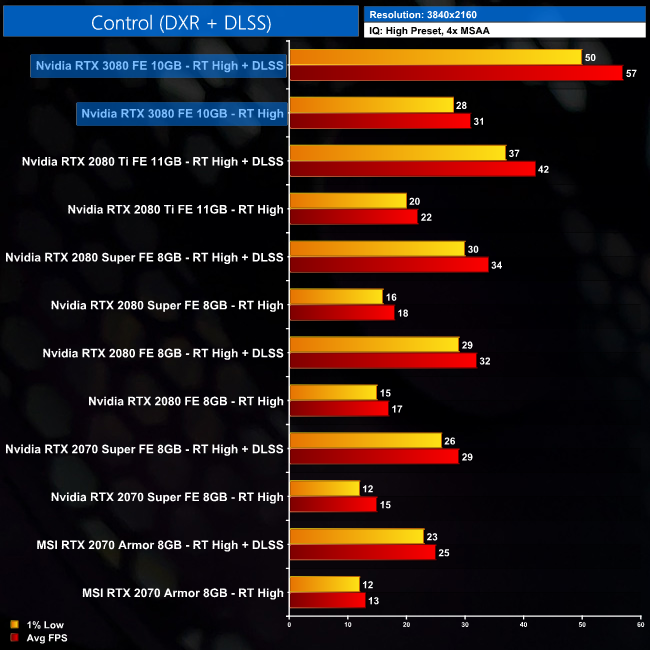
Both Control and Death Stranding support DLSS 2.0, so we test both at 4K with and without DLSS (using the Quality mode). We tested Control with RT set to High, while Death Stranding does not support RT features.
In both cases, the performance jump is healthy – Control gets by far the biggest FPS boost of the two, gaining an extra 84% compared to DLSS Off.
As for Death Stranding, the results aren't as impressive, with FPS increasing by 35%. This is actually slightly worse scaling than the 2080 Ti, which gets a 47% boost by enabling DLSS. We asked Nvidia about this and were told that scaling will taper out at higher FPS ‘due to the large amounts of data to handle.'
One of the concerns we have heard from enthusiasts in the build up to this launch has been in regards to the amount of memory supplied with the RTX 3080, and particularly the 8GB RTX 3070. While we can't comment on the latter card today, I thought it would be worth taking a look at all the games we tested and their amount of VRAM requested by each.
A word of caution, though – it is not an exact science when dealing with VRAM usage, particularly as tools like GPU-Z or MSI Afterburner will show requested memory instead of actual usage. This makes it challenging as games can request significantly more memory than is actually needed, so do bear that in mind.
The numbers are certainly interesting. I would disregard The Division 2 as the game was requesting up to 9GB VRAM even when sitting in the settings menu, so for me that is certainly a case of the game making sure it doesn't run out of memory by requesting pretty much everything that was available.
Other than that, considering this is a 10GB card, in 7 of the games we tested at 4K, we saw requested VRAM remain below 8GB, with titles like Metro Exodus and Red Dead Redemption 2 barely needing more than 5GB.
Shadow of the Tomb Raider is high on the list, but again it is hard to say whether the game needs this much memory, or it is simply requesting that much.
Right now, I can't see 10GB VRAM being an issue, and particularly so for 1440p gamers. At 4K, it is possible we could run into problems down the line, but I'd say we're still a couple years away from that happening. The flipside is, if you're upgrading from a GTX 1080 Ti, or something even older, you may want the 3080 to last several years before upgrading again, at which point is is very possible, and likely, that 10GB will be a limiting factor during the lifespan of the GPU.
According to Nvidia, it's a balancing act between cost and performance. Justin Walker, product manager for desktop GeForce GPUs, said the following: ‘We’re constantly analyzing memory requirements of the latest games and regularly review with game developers to understand their memory needs for current and upcoming games. The goal of 3080 is to give you great performance at up to 4k resolution with all the settings maxed out at the best possible price.
In order to do this, you need a very powerful GPU with high speed memory and enough memory to meet the needs of the games. A few examples – if you look at Shadow of the Tomb Raider, Assassin’s Creed Odyssey, Metro Exodus, Wolfenstein Youngblood, Gears of War 5, Borderlands 3 and Red Dead Redemption 2 running on a 3080 at 4k with Max settings (including any applicable high res texture packs) and RTX On, when the game supports it, you get in the range of 60-100fps and use anywhere from 4GB to 6GB of memory.
Extra memory is always nice to have but it would increase the price of the graphics card, so we need to find the right balance.'
Here we present the average clock speed for each graphics card while running the 3DMark Time Spy stress test for 30 minutes. We use GPU-Z to record the GPU core frequency during the Time Spy runs. We calculate the average core frequency during the 30 minute run to present here.
Click to enlarge.
In terms of overall clock speed behaviour, Ampere doesn't appear to have changed anything compared to Turing. GPU Boost will still push clock speed well above the rated frequency, before settling down as temperature increases. These adjustments still happen in steps of 15MHz so those hoping for more granular control will be disappointed.
As for the actual speed on the RTX 3080, it's boosting to pretty much the same levels as last generation's Founders Editions. It may not be exactly as fast – the 2080 Super was clocked quite aggressively – but considering the rated boost clock is lower at 1710MHz, the average frequency just shy of 1860MHz is good to see.
For our temperature testing, we measure the peak and steady state GPU core temperatures under load. This data comes from running the 3DMark Time Spy stress test for 30 minutes.
Thermal performance from the Founders Edition is very consistent. The GPU core steadily increased in temperature over the first five minutes, unit it hit 76C in our testing, where it plateaued for the remainder of the stress test.
This puts actual GPU temperatures pretty much in line with the 20-series Founders Editions, so the new design for the 30-series won't radically reduce temperatures to sub-60C levels.
However, we do have to bear in mind that the RTX 3080 has increased rated power draw over the RTX 2080 Ti by 28%, so to see the same sort of thermal performance (or better, when specifically comparing to the 2080 Ti) is highly impressive.
We take our noise measurements with the sound meter positioned 1 foot from the graphics card. I measured the noise floor to be 32 dBA, thus anything above this level can be attributed to the graphics cards. The power supply is passive for the entire power output range we tested all graphics cards in, while all CPU and system fans were disabled. A reading under load comes from running the 3DMark Time Spy stress test for 30 minutes.
Following on from our thermal testing, in terms of overall noise from the card we measured 39dB at a distance of 30cm, with both fans spinning at 1880rpm. This is, once more, pretty much in line with the 20-series Founders Editions. However, as with the thermal performance, Nvidia has created a card that requires significantly more power than the previous generation, yet is no louder – and is still quieter than the RTX 2080 Ti.
For me, this just goes to show how good a design the new RTX 3080 is. The card is cooler and quieter than the RTX 2080 Ti, all while out-performing it and demanding 28% more power. It will be fascinating to see how Nvidia's partners fare with their custom cards.
We measure system-wide power draw from the wall while running the 3DMark Time Spy stress test for 30 minutes.
It's no shock to see the RTX 3080 sitting top of the chart here, with total system power draw about 70W higher than the RTX 2080 Ti, or 110W higher than with the RTX 2080. This is expected considering the GPU's TGP is rated at 320W, the highest for any single-GPU that I can remember.
While total system power draw isn't an ideal metric for comparisons, we're seeing roughly 33% higher power draw than the RTX 2080. Directly comparing the rated TGPs of each card, the 3080's is 42% higher, while delivering on average 68% increased performance at 4K – certainly suggesting some efficiency improvement relative to that GPU.
On the other hand, the 3080 is 31% faster than the 2080 Ti at 4K, while it's rated TGP is 28% higher, so that is much more ambiguous when it comes to efficiency improvements.
Ultimately, I'm not sure many people will be too bothered about the increased power. It's certainly not the same situation as something like the GTX 1080, which delivered increased performance at significantly less power than the GTX 980 Ti, but most gamers will simply be glad to be seeing big gen-on-gen performance improvements again, even if power draw has gone up.
Following on from our total system power draw testing on the previous page, we re-ran some of our tests, this time looking at the Board Power metric as reported by GPU-Z. This is currently only available for Nvidia cards, which is why we have excluded AMD results from the chart. Aside from the fact this is software-based reporting, and not a hardware measurement of the PCIe power cables and PCIe slot (for that we'd need something like PCAT), this should provide us more accurate data to work with as it is measuring only the GPU power, and not total system power which is a fundamentally imprecise measurement.
First up, here is the average Board Power for all of the Nvidia GPUs we tested, measured across a 30-minute 3DMark Time Spy run.
Then, by using this data in conjunction with the 11-game average FPS data we presented earlier in this review, we can work out performance per Watt for each graphics card. This is presented as FPS per Watt.
The data here more-or-less confirms our thoughts from the previous page, namely that the RTX 3080 sees a larger (13%) performance per Watt improvement when compared to the RTX 2080, than it does compared to the RTX 2080 Ti (just 4%). It is still an improvement, yes, but it is clear Ampere is all about the performance, with efficiency gains seemingly less of a priority here.
Up next we come to overclocking the RTX 3080. This works slightly differently to the 20-series, as I discovered during my test, so we've presented data slightly differently to how we usually would.
In a nutshell, overclocking the core is straightforward – I increased the offset slider until I hit instability. With my sample, that wasn't high, with anything over +60MHz resulting in application or game crashes.
With the memory, however, we see different behaviour. With GDDR6 on Turing cards, we could push the memory to a certain point – usually +800 or +900 MHz offsets – until artifacting or other instability issues would occur. Now, instead of hard crashes, Nvidia had adjusted the memory so users will actually see reduced performance when pushing an overclock to far, though crashing can still occur at the extreme end.
Here's how they explained it to us:
“One of the design features we added to enhance memory reliability is transaction error detection and replay. That is, when the encoding shows that there has been a data transmission error, the transmission in error is re-tried or “replayed” until a correct memory transaction is successful. As you push overclocks and cause more errors, the re-tried transactions reduce useful memory bandwidth and thus reduces performance.
This feature actually increases memory frequency capability and pushes out the artifacts, crashes, and other negative impacts of overclocking to higher frequencies. Crashes can still happen if frequencies are pushed too hard. So, if performance starts dropping, you've actually passed the limit at which the system would have crashed. Rather than rebooting as feedback, plateauing performance indicates you’ve hit the limits of OC.”
To demonstrate this new behaviour, we tested three games, plus 3DMark Fire Strike, with the memory overclocked at different intervals, using 100MHz steps.
The trend is clear to see – push the memory beyond 900MHz or so, and performance will drop off. Going for a +1000MHz offset resulted in a small performance hit, but adding another 100MHz saw the numbers plummet faster, while a +1200MHz offset basically ground the system to a halt.
Like we already said, our sample was only able to add 60MHz to the core, which is a little disappointing, but this could well be the silicon lottery, and we will have a number of AIB cards to test to see if they can overclock further. With a +60MHz GPU offset and a +800MHz memory offset, the gains on offer from the games tested above worked out between 7-8%.
There's no two ways about it. Nvidia's RTX 3080 is a stunning return to form for the manufacturer, delivering hugely impressive gen-on-gen gains compared to the RTX 20-series that debuted two years ago. The 3080 is the fastest graphics card we have ever tested (though the RTX 3090 will have something to say about that next week), and it is delivered at almost half the price of last generation's flagship, the RTX 2080 Ti.
The most disappointing aspect of the RTX 20-series was its marginal improvements in terms of traditional raster performance. Ray tracing aside, unless you were willing to pay the big bucks for the 2080 Ti, we didn't get any GPUs that delivered a big generational jump in performance. It seems Nvidia took that disappointment as a challenge; with the RTX 3080, Nvidia has delivered a huge jump forward.
That's because, on average, the RTX 3080 improves on the RTX 2080 by 68% at 4K resolution, while it's also 31% faster than the RTX 2080 Ti and 58% faster than the 2080 Super. Anyone who held onto a GTX 1080 Ti will also see performance increases to the tune of 90%, again at 4K. Across the aisle, AMD is now in real need of Big Navi to deliver the goods when it arrives on October 28, as the 3080 crushes the Radeon VII by 86% and it's over twice as fast as the RX 5700 XT, again at 4K.
The margins of victory for the RTX 3080 do change as we step down in resolution – it's 31% faster than a 2080 Ti at 4K, 25% faster at 1440p and 18% faster at 1080p. The latter resolution proved a significant problem on a number of occasions due to CPU bottlenecks. Even with an i9-10900K running at 5.1GHz, the CPU was holding the 3080 back by a significant margin in at least 5 of the 11 titles we tested today. Even where the bottlenecks weren't as significant, relative gains versus the 2080 Ti were lower at 1080p than 1440p or 4K, in every single game we tested. Gamers looking to buy this GPU will certainly get the most out of it at 4K, though a 55% increase in performance over the RTX 2080 at 1440p shows high refresh rate WQHD users will also get their money's worth.
However you slice it, RTX 3080 is a huge step forward from Turing. Of course, it is easy to be cynical and point out the fact that Turing hardly improved on Pascal in terms of traditional raster performance at this price point, and that does make Ampere look more attractive than it should. There may be an element of truth there, but even the gains versus Pascal look impressive considering the GTX 1080 Ti came out three and a half years ago. The 3080 is 90% faster on average at 4K, but over 120% faster in certain titles like Control and The Division 2.
It's also good to see RTX performance taking a significant stride forward. The improvements to the RT cores and overall architecture mean relative performance with RT on scales slightly better than with it off – gains of around 35-40% compared to the 2080 Ti were typical in our testing. Of course, enabling the technology still results in a significant hit to performance, but as 3080 has pushed things so far forward, the end result isn't nearly as bad as it was with Turing. In Shadow of the Tomb Raider, for instance, we saw average frame rates hitting nearly 90FPS at 1440p with RTX set to Ultra, while Metro Exodus was averaging over 110FPS at the same resolution, again with RTX set to Ultra.
Whether or not this is a selling point for you is really going to be personal preference, and admittedly the list of games with ray tracing features – while growing – is hardly all-encompassing. Still, the more people that buy RTX 3000 for its improvements to rasterised performance only increases the number of people who can enable RTX features in titles they do want to play – games like Cyberpunk 2077, Crysis Remastered and Watch Dogs Legion – thus potentially fuelling developers to focus more on implementing the technology in more games.
The one question mark around overall performance comes down to that 10GB framebuffer. The use of Micron's GDDR6X memory, coupled with a wider memory interface, sees total memory bandwidth improve by 23% compared to the 2080 Ti, but it's really an unknown how the 10GB capacity will fare with 4K gaming as we head into 2021 and beyond. Nothing in my testing suggests it's a factor now, and I'd imagine it's at least a couple of years before it starts making a difference. Even then, considering the 3080 is significantly faster than the 2080 Ti, but has less VRAM, there is a question mark about how that will affect performance in the future.
I have also been hugely impressed with Nvidia's new Founders Edition design. The cooler has been redesigned from the ground up around delivering optimal airflow within a chassis, resulting in a dual-axial design with one fan pushing air from the underside of the card, and another fan pulling air through the heatsink from the top.
The end result is a graphics card that runs around 76C under load, which is pretty much in line with the 2080 Super Founders Edition, while producing a similar amount of noise. What makes this so impressive, is the fact that the cooler can perform like that all while dealing with the card's 320W TGP – a significant increase in power versus last generation.
As for that increase in power draw, I can't say I am too concerned. Nvidia clearly decided all-out performance gains were more important than huge efficiency increases with Ampere, and I think pretty much every gamer out there would agree. If anything, I am now even more keen to assess custom boards from the likes of Gigabyte, ASUS and MSI to see how Nvidia's partners have designed around the increase in power.
Another reason I am keen to see those AIB cards is because my Founders Edition sample was a limited overclocker. I could only add an extra 60MHz to the GPU core, while changes to memory overclocking mean pushing a memory OC too far will result in performance degradation. My best result came with a memory offset of +800MHz.
All told, Nvidia's RTX 3080 is a simply stunning graphics card. It's a huge leap forward compared to the RTX 2080, while also being cheaper at £649, compared to £749 for the RTX 2080 at launch. This is certainly the type of performance increase we wanted to see from Turing, and I imagine many Pascal owners will indeed be upgrading, having skipped the 20-series.
Is it worth waiting for Big Navi? If the rumours around limited supply for the RTX 3080 are true, it's possible the wait will be enforced for many who can't buy Ampere at launch. Still, we don't know anything about Big Navi yet, so those determined to get the best deal may consider waiting. Right now, all we can really say is RDNA2 will need to respond decisively to this launch, as Nvidia has just set the bar – and boy have they set it high.
RTX 3080 Founders Edition has a UK MSRP of £649 and will be available for purchase directly from Nvidia HERE. Custom cards will be available from Overclockers UK starting at £649.99 HERE.
Discuss on our Facebook page HERE.
Pros
- Huge leap in performance compared to the RTX 20-series.
- RTX gaming is significantly more viable.
- Cost per frame leader.
- Still offers an increase in performance per Watt versus Turing, despite high power draw.
- Beautiful new Founders Edition design.
- Cooler and quieter than a 2080 Ti Founders Edition, despite the increased TGP.
Cons
- 10GB VRAM may be a limiting factor for 4K gaming in the future.
- Power draw is high.
KitGuru says: It is hard to be anything but highly impressed with Nvidia's RTX 3080. This graphics card sets a new standard for 4K gaming, and does so while significantly improving on the RTX 20-series in terms of value.
 KitGuru KitGuru.net – Tech News | Hardware News | Hardware Reviews | IOS | Mobile | Gaming | Graphics Cards
KitGuru KitGuru.net – Tech News | Hardware News | Hardware Reviews | IOS | Mobile | Gaming | Graphics Cards


